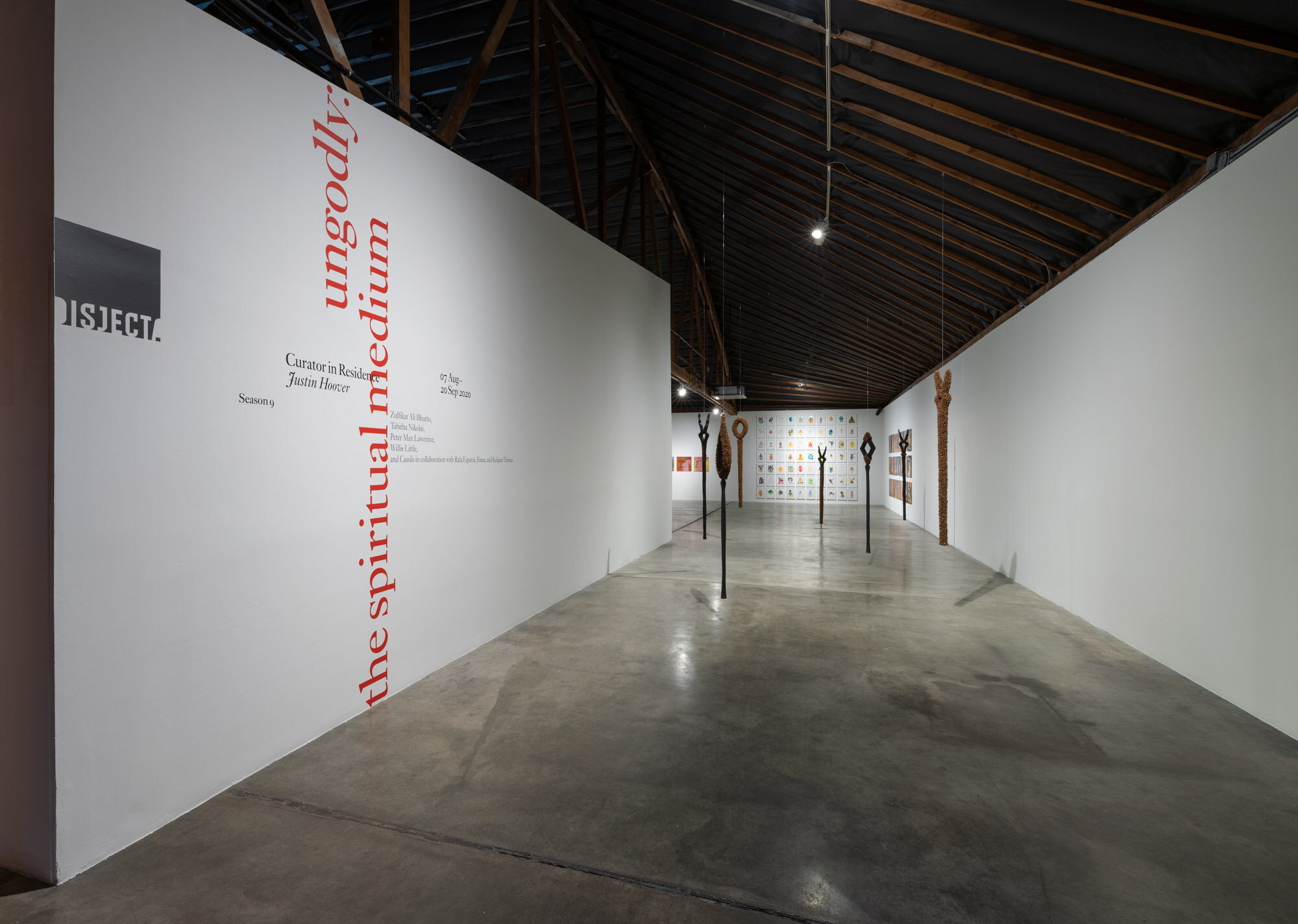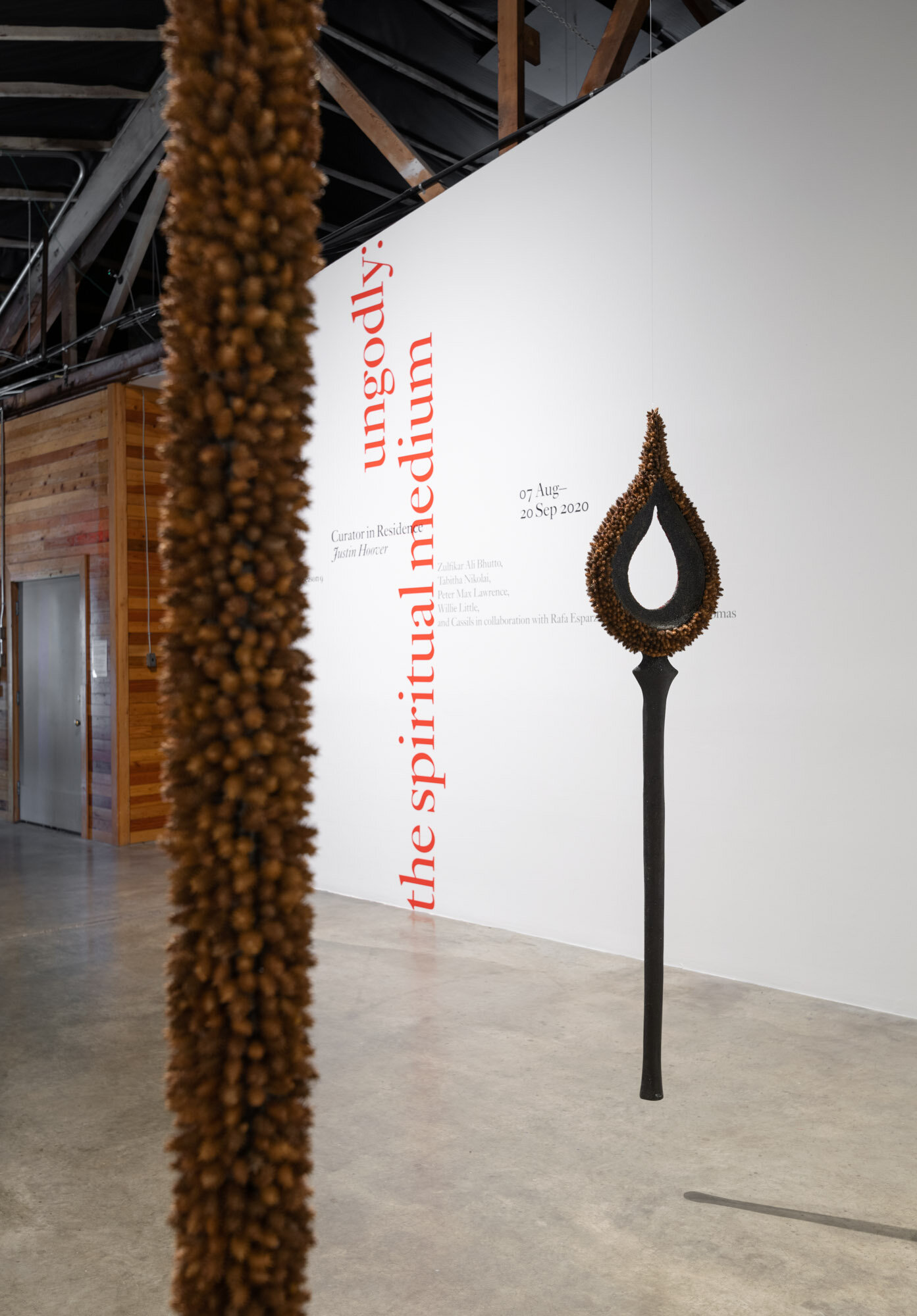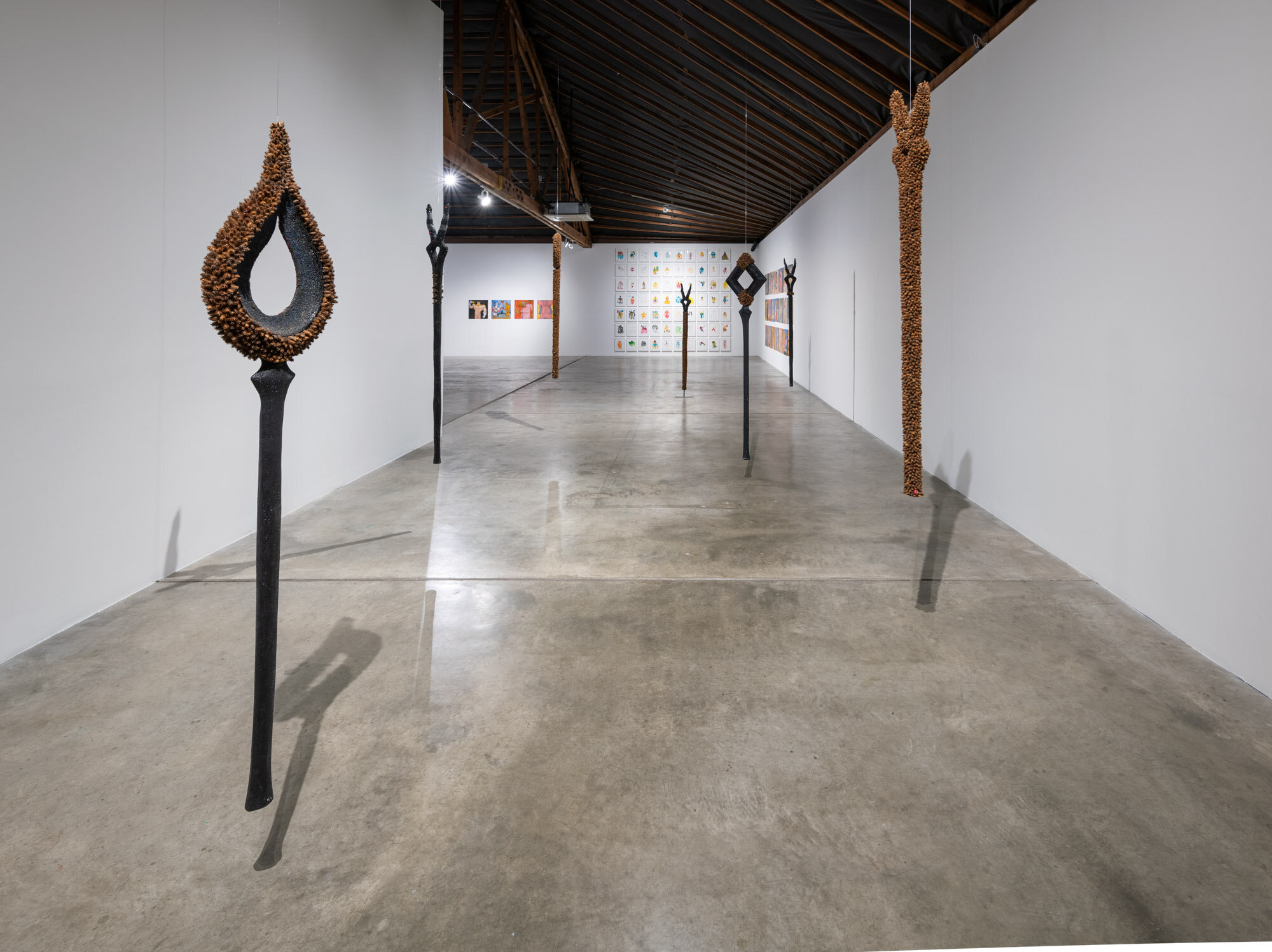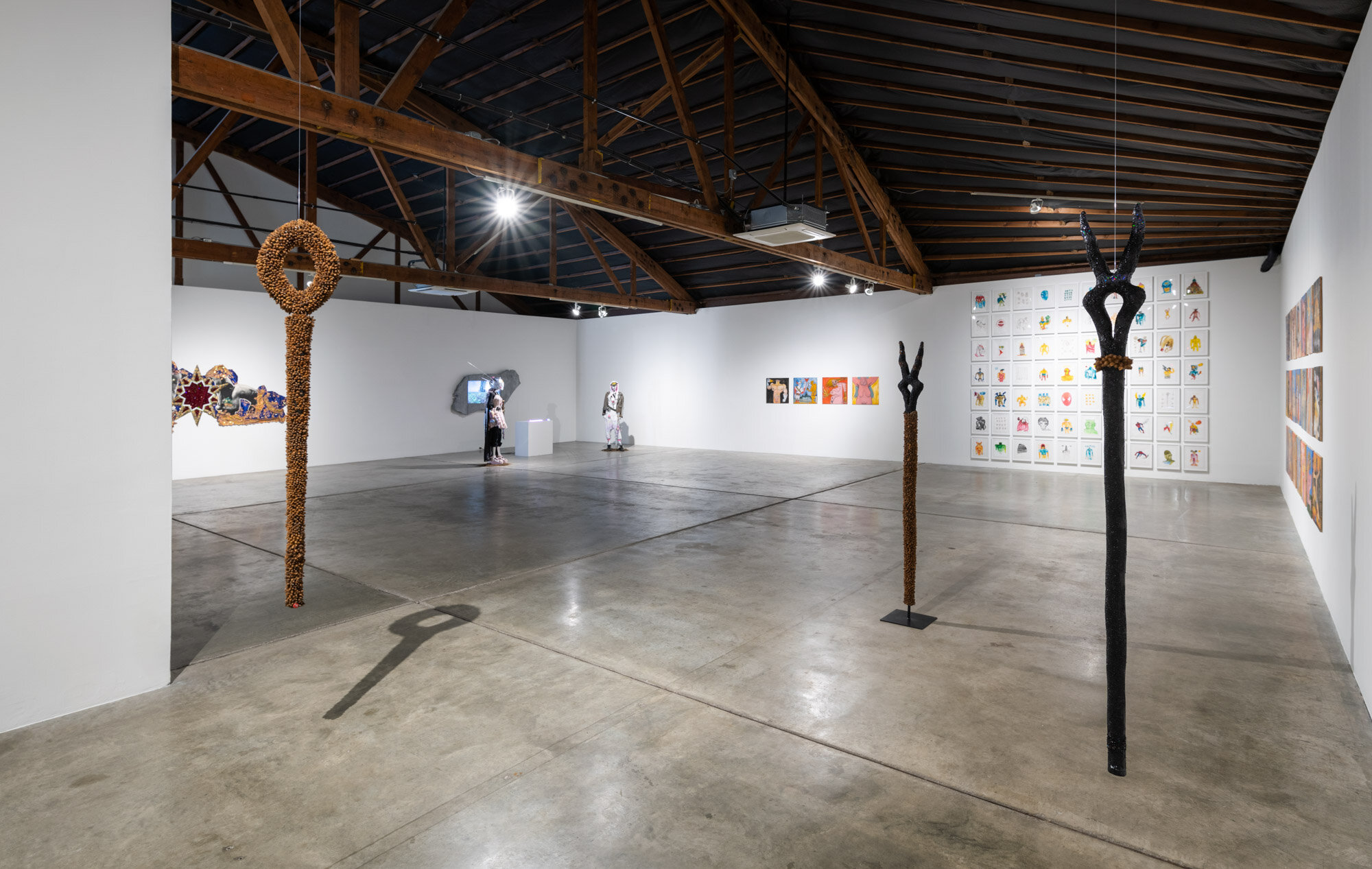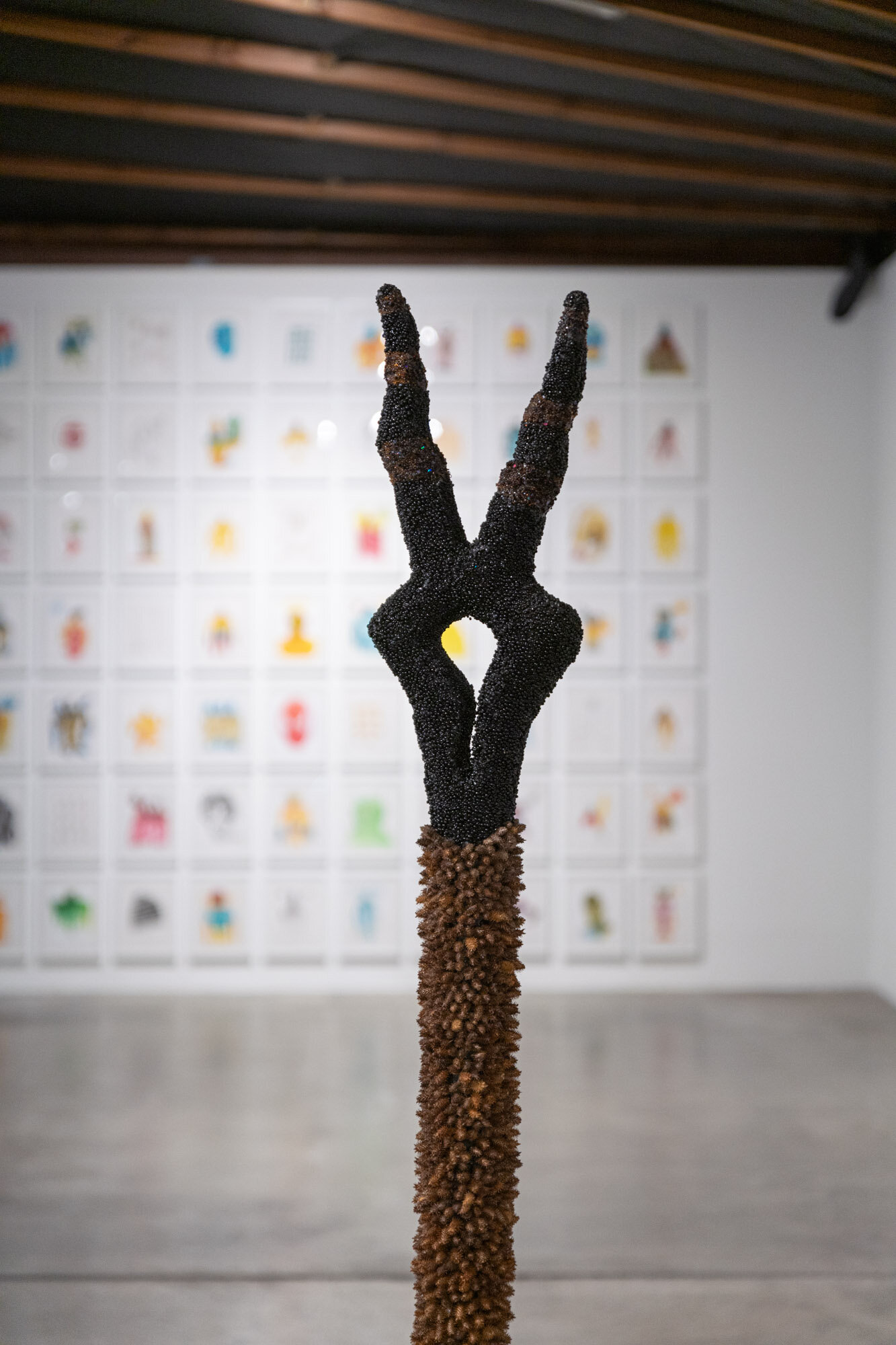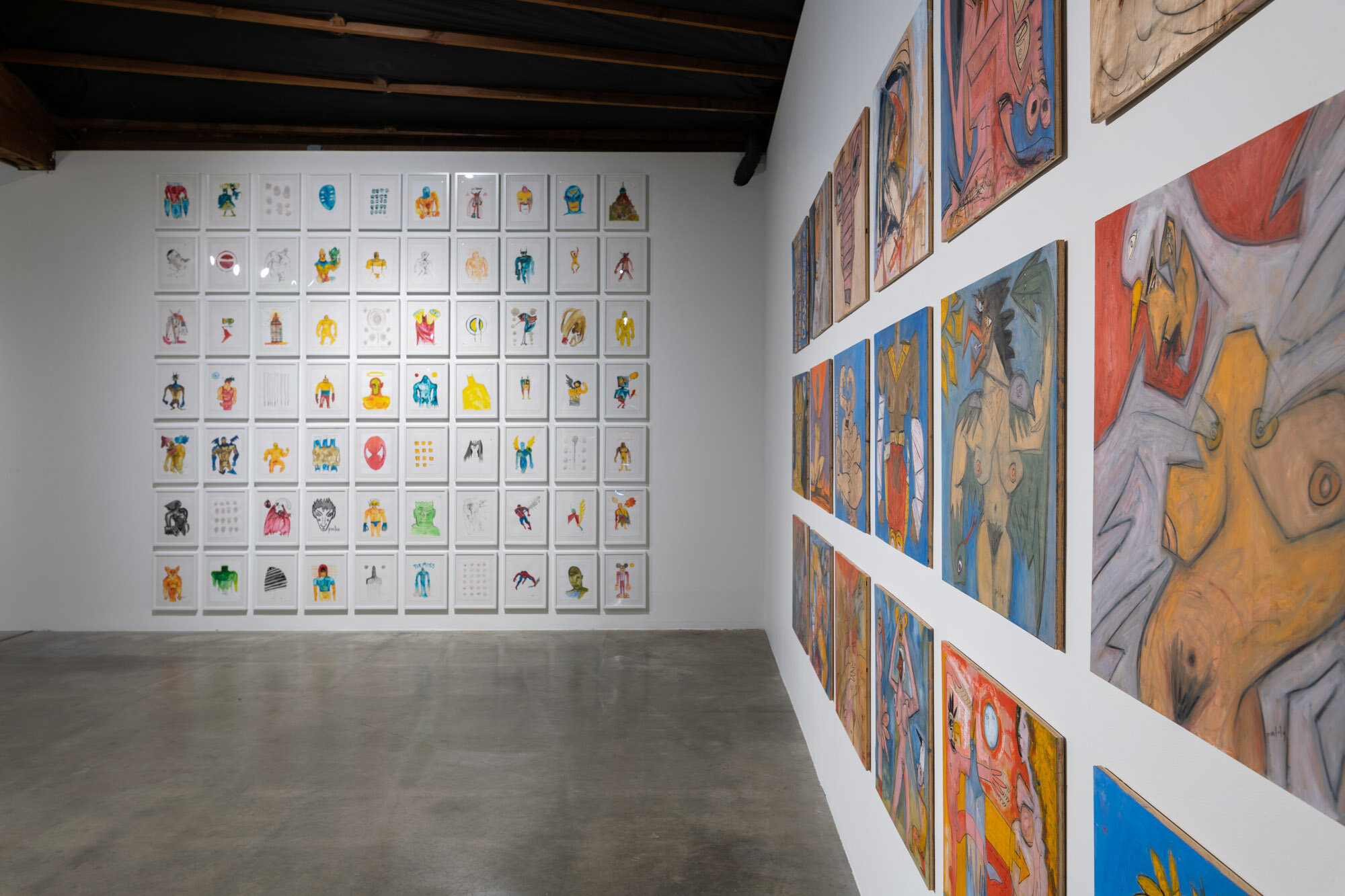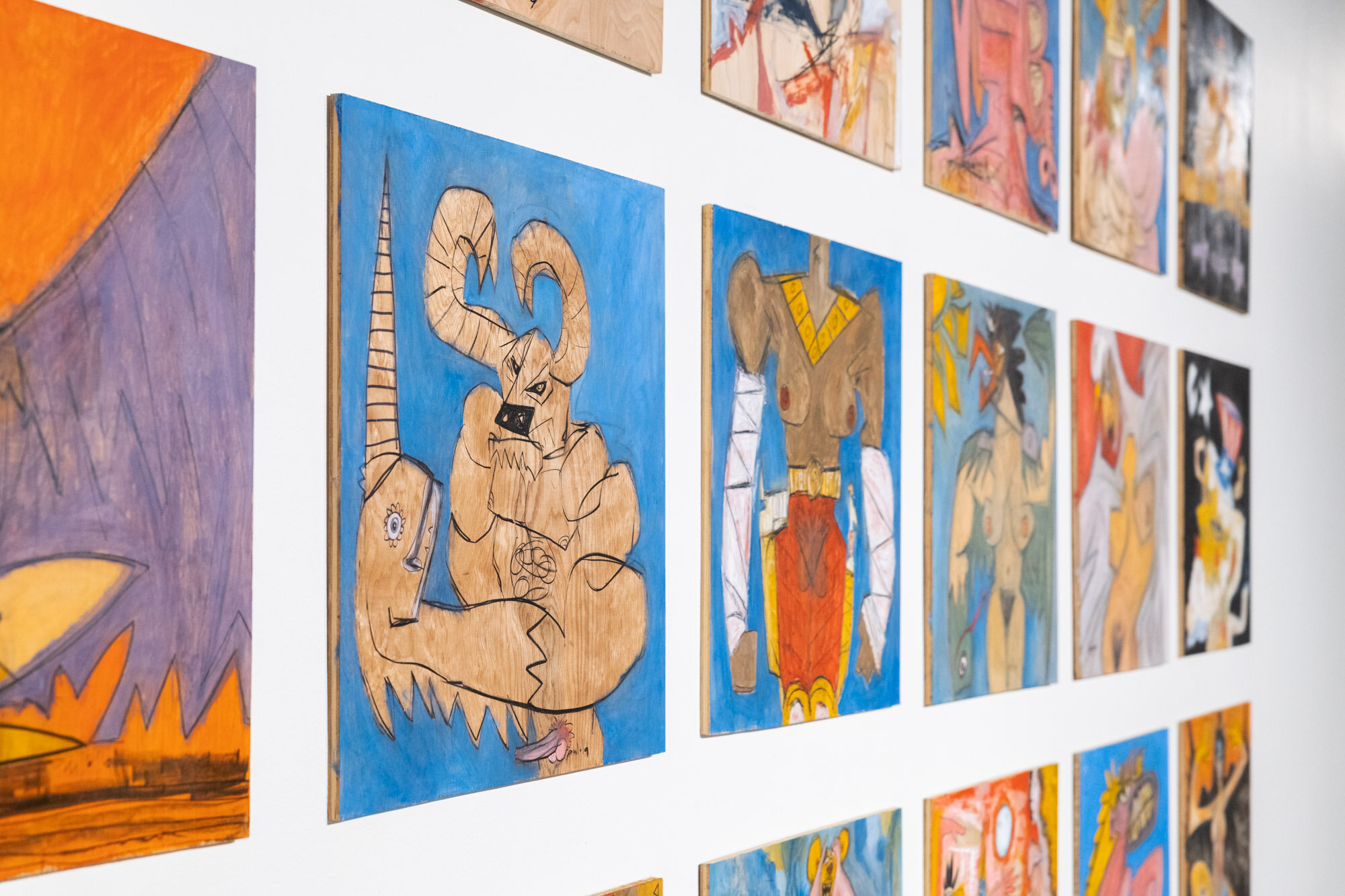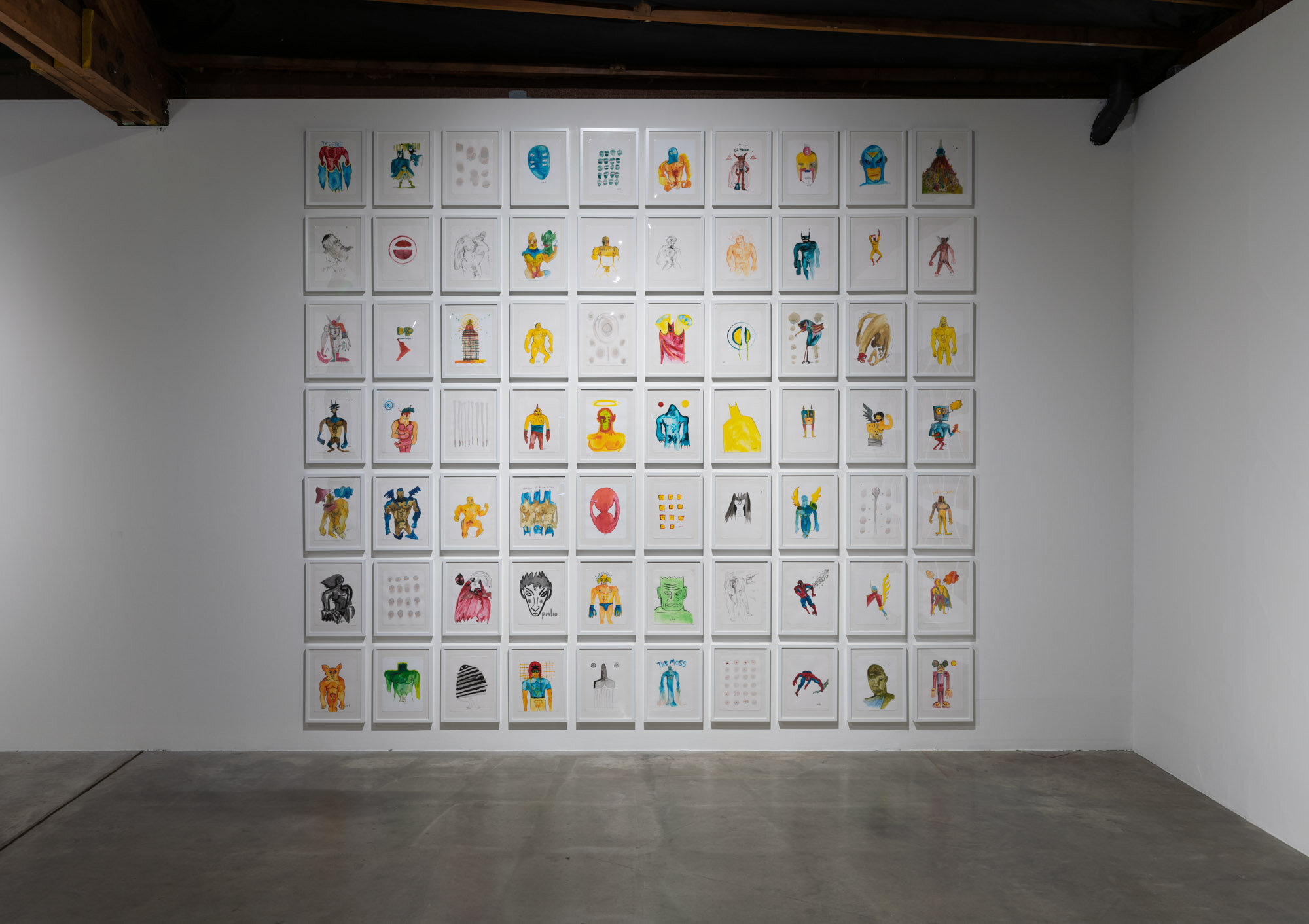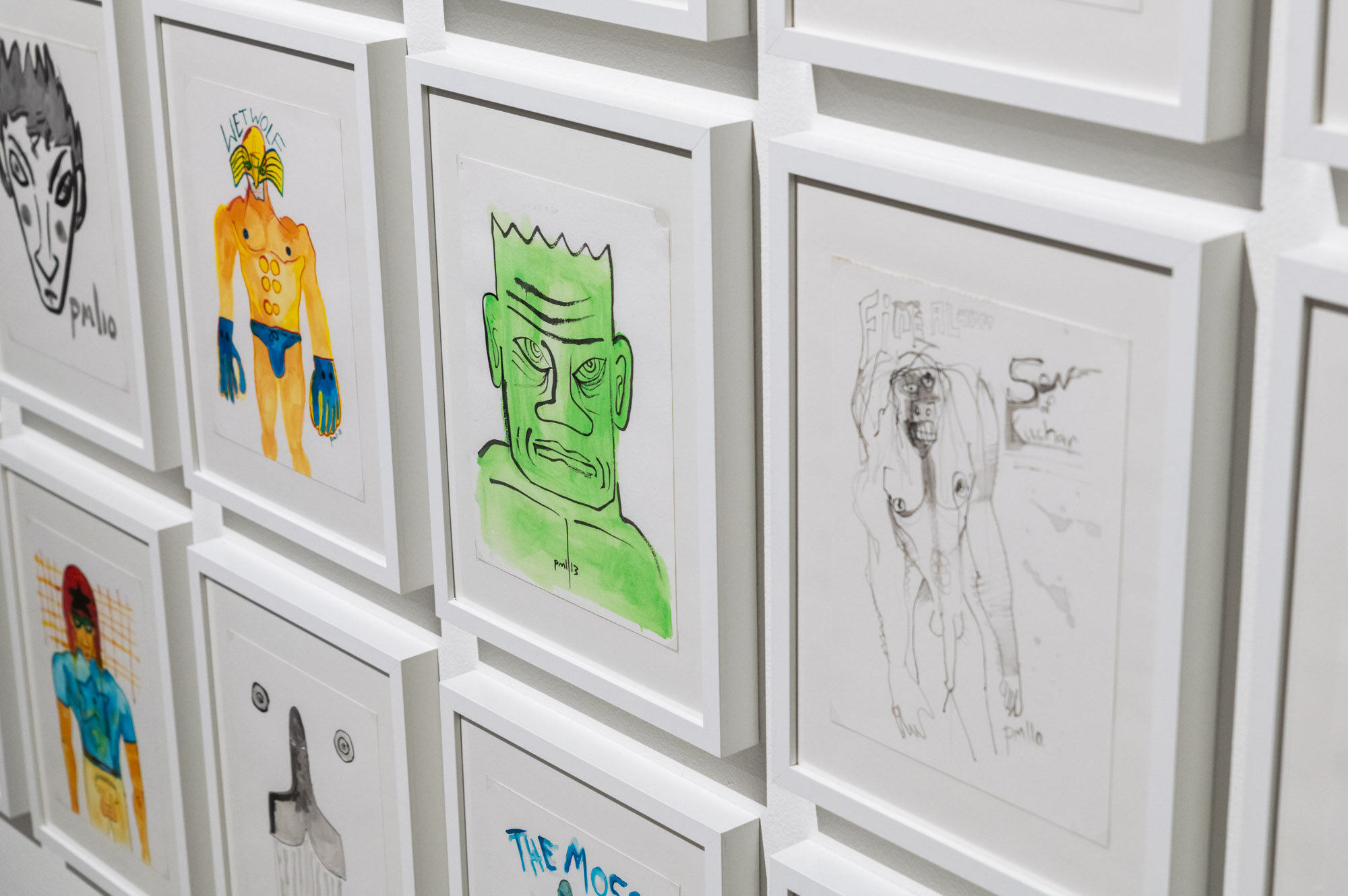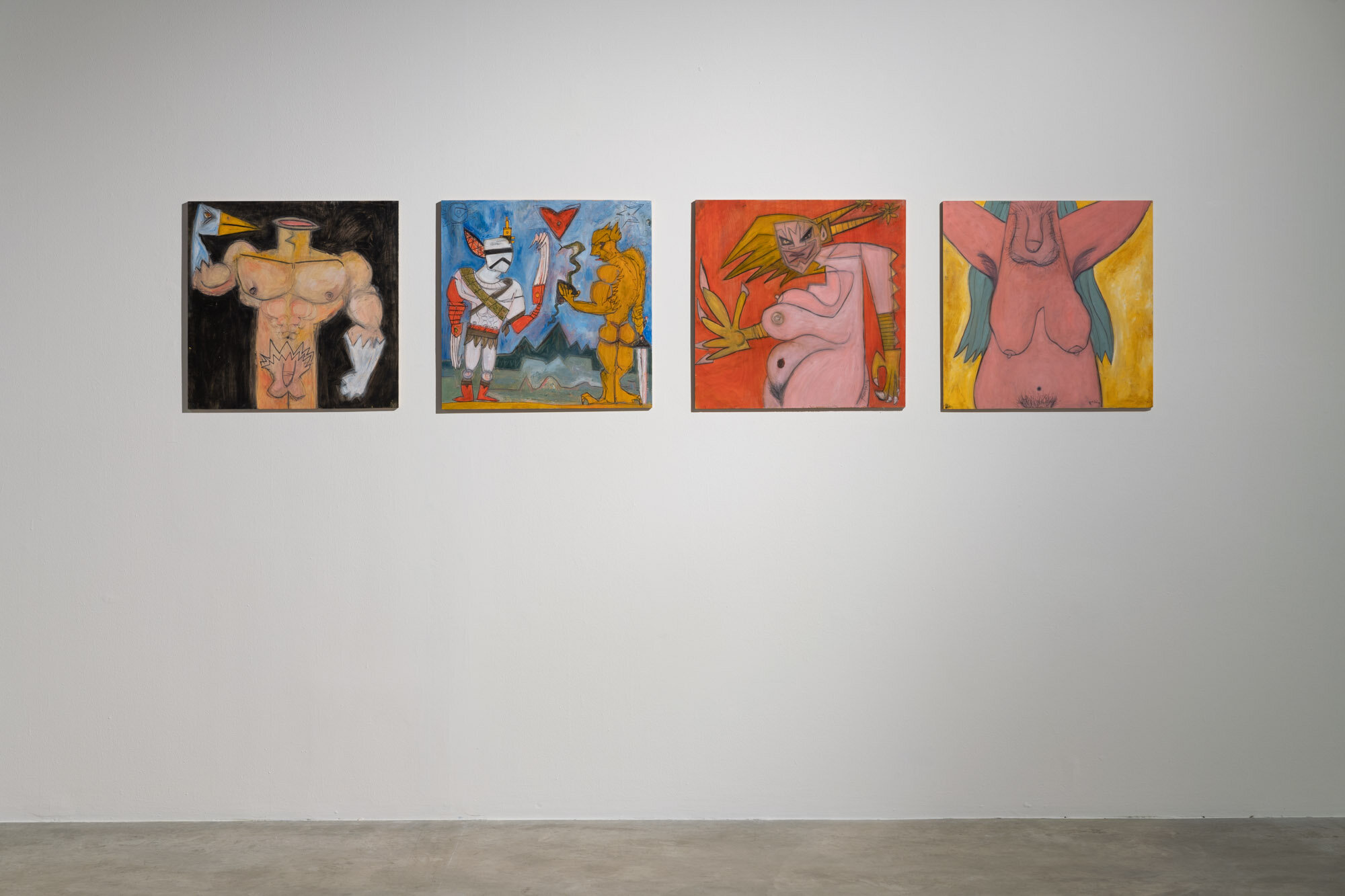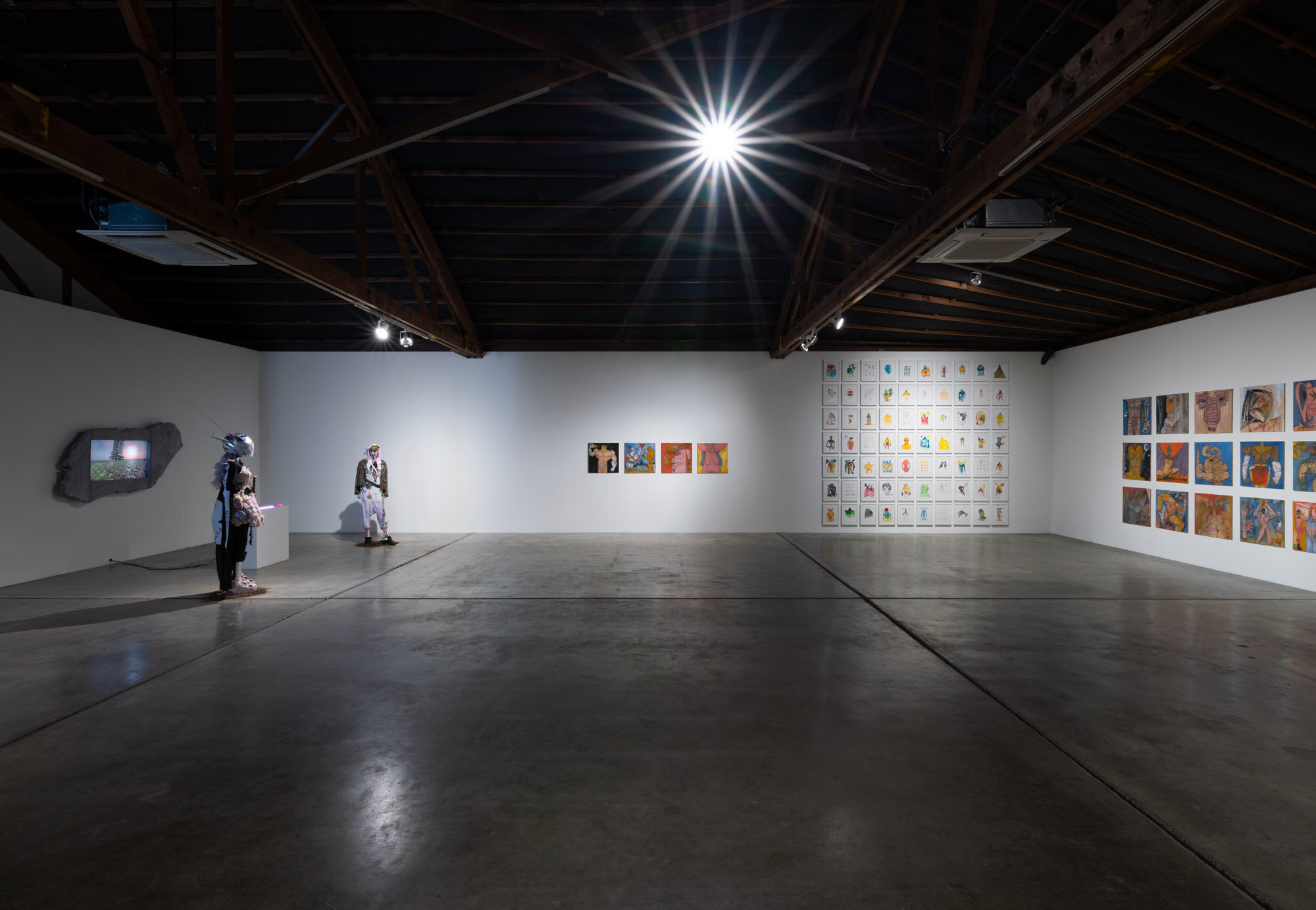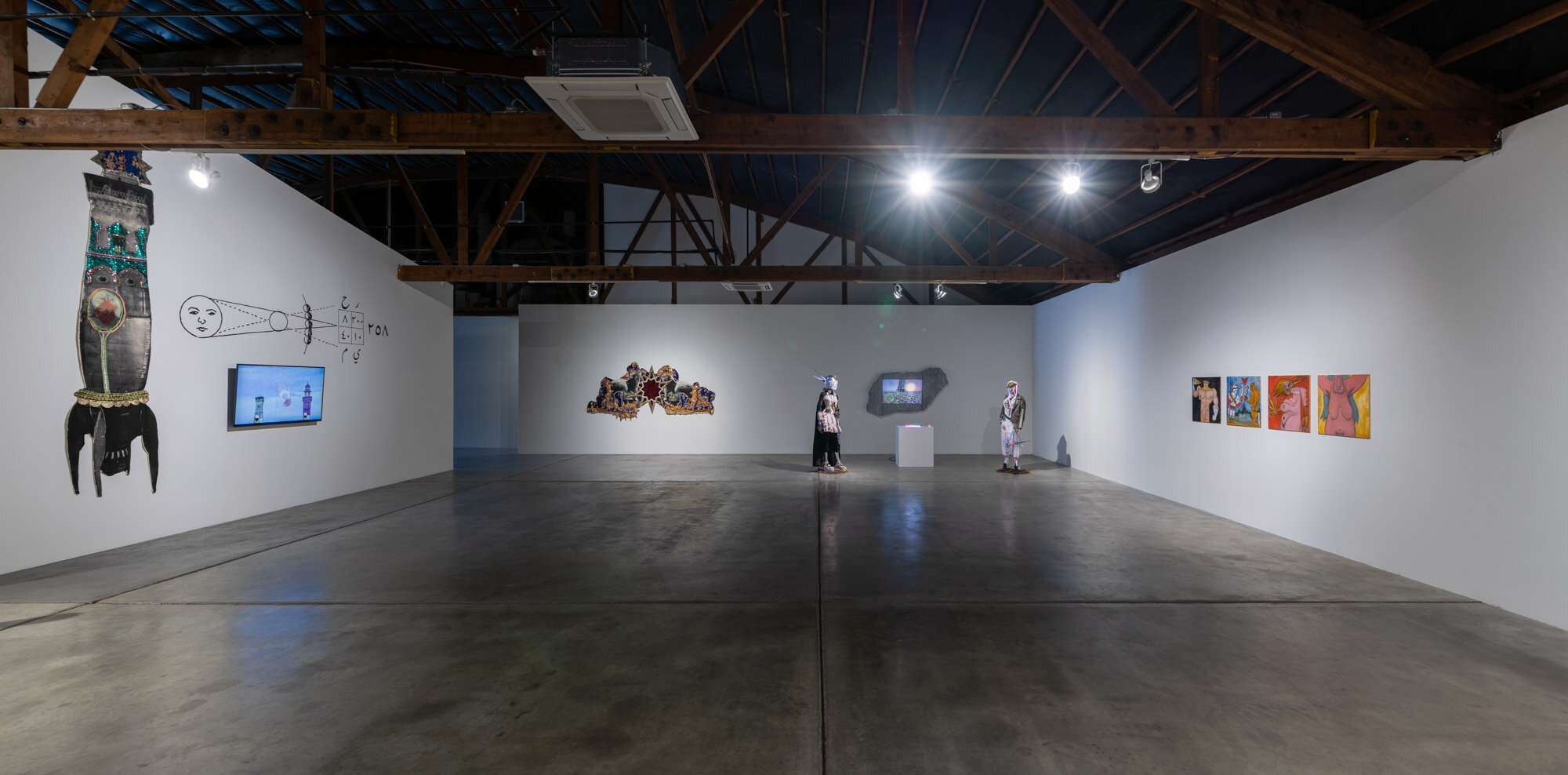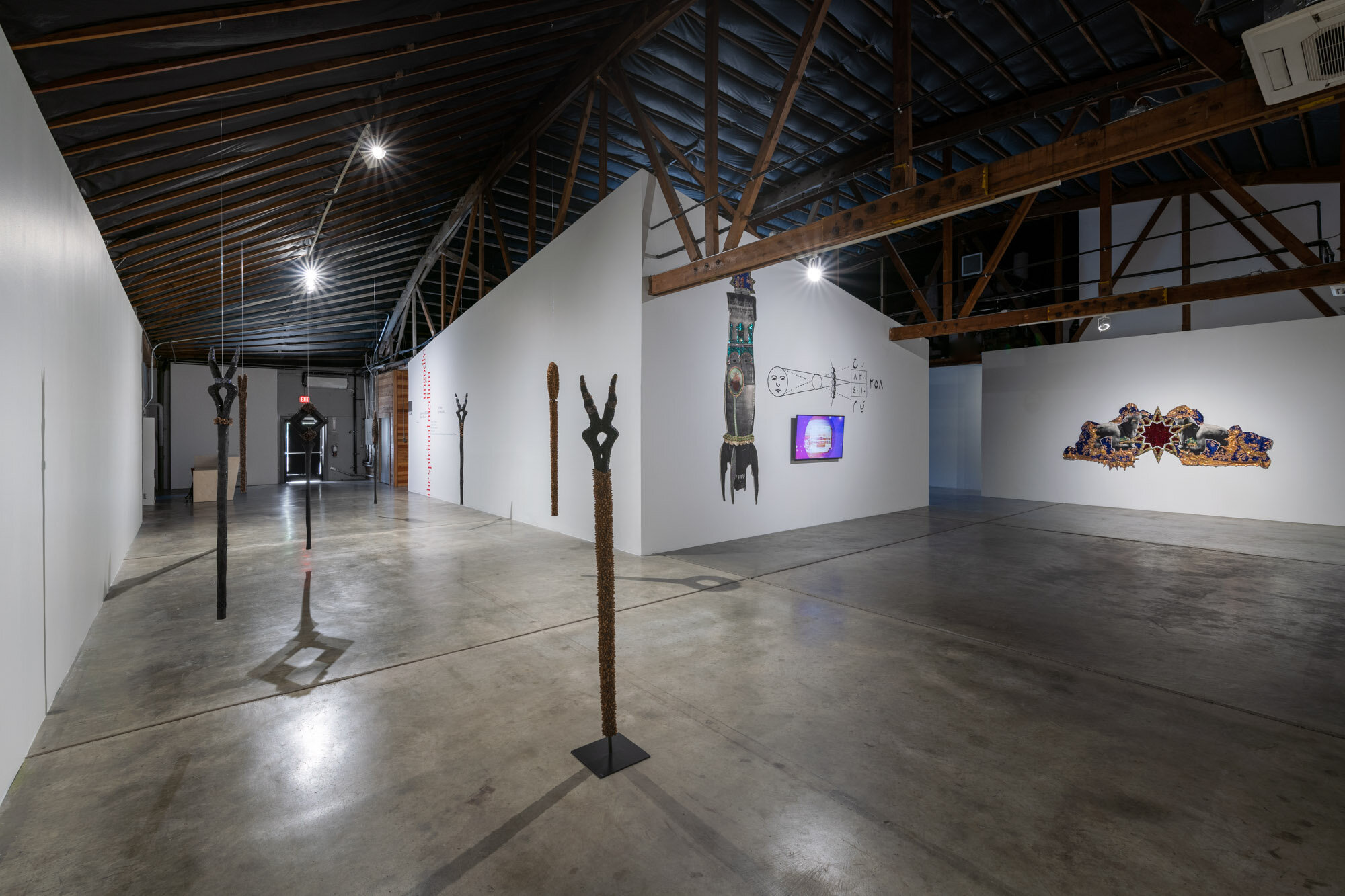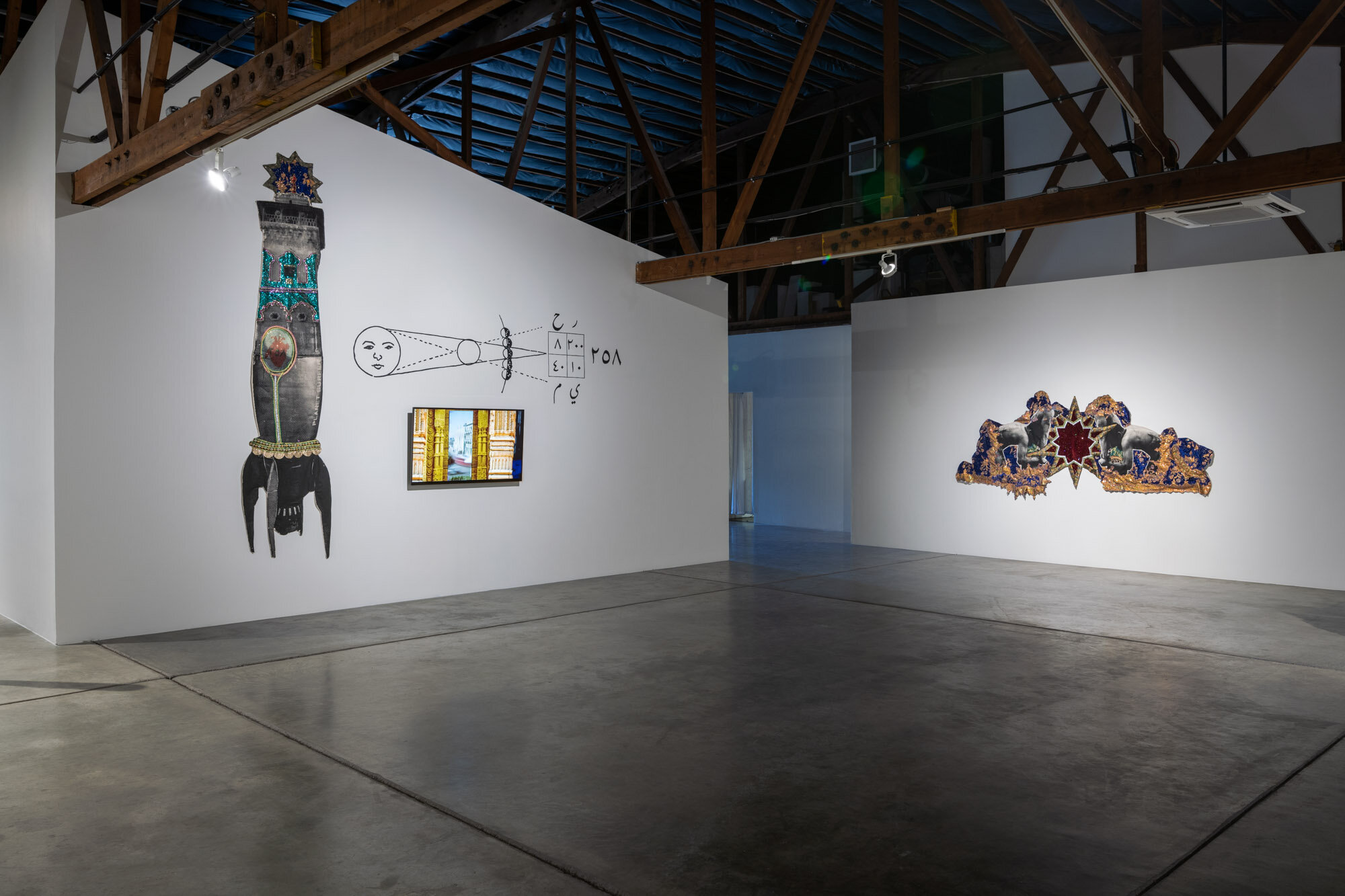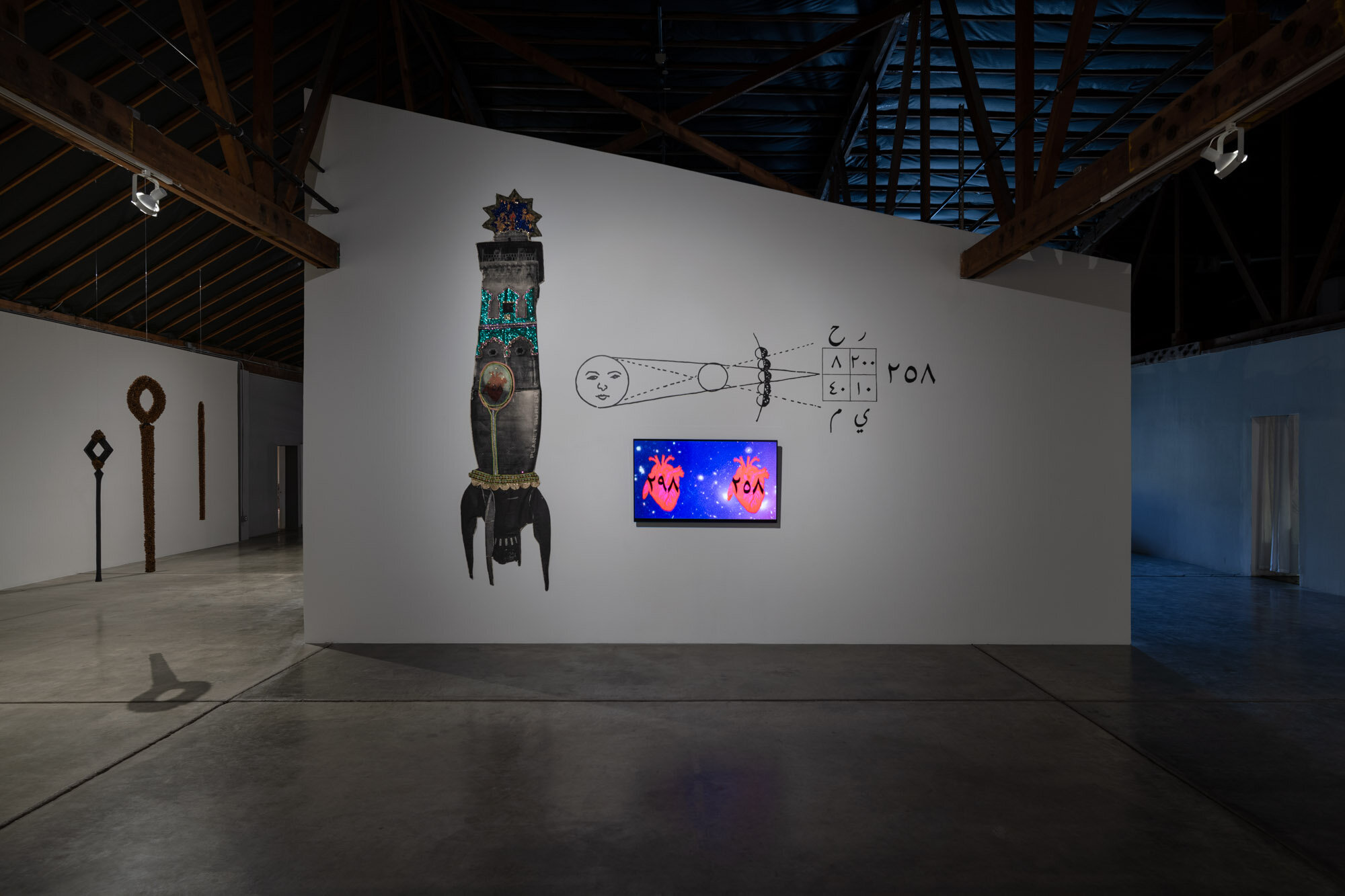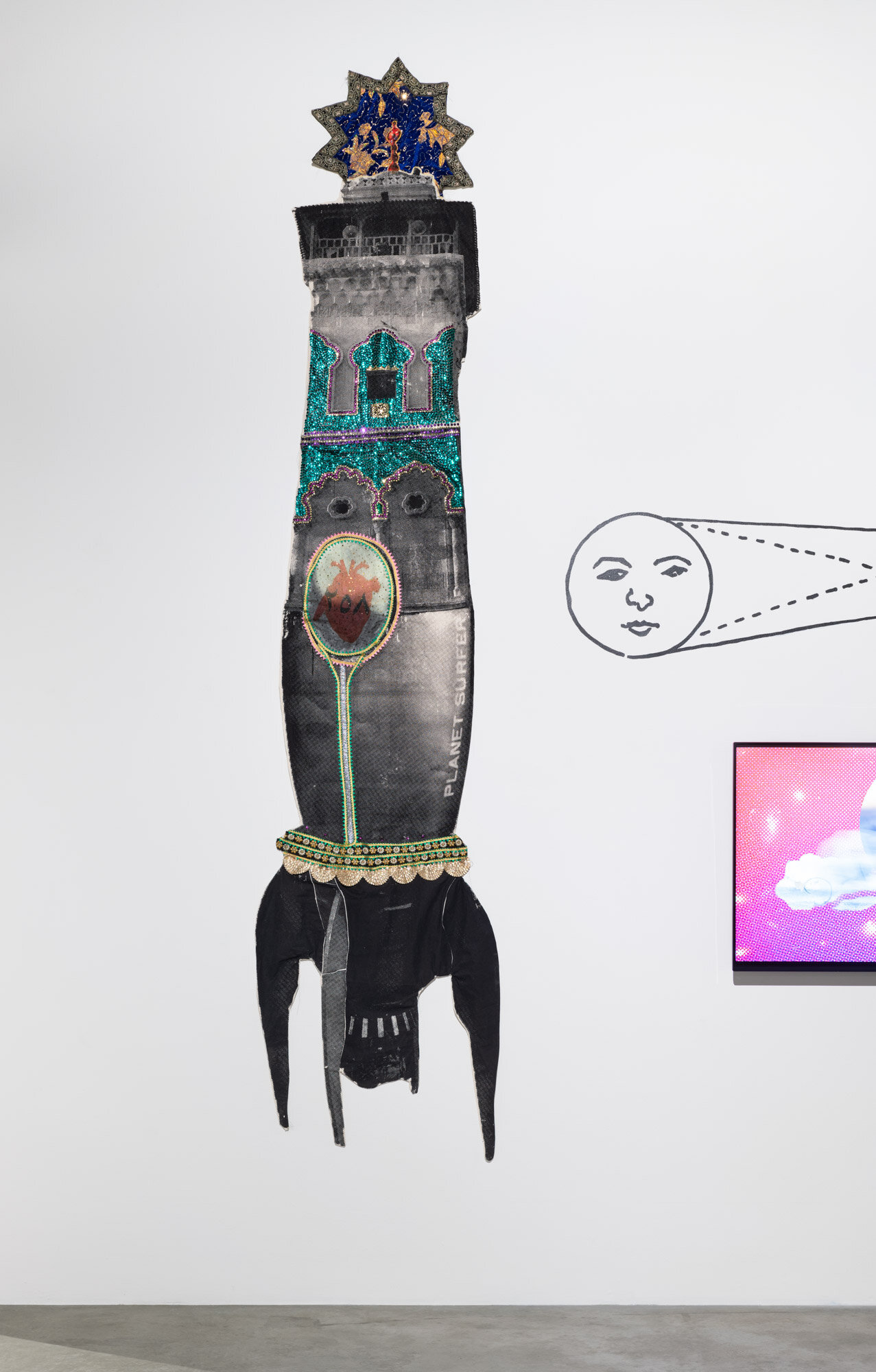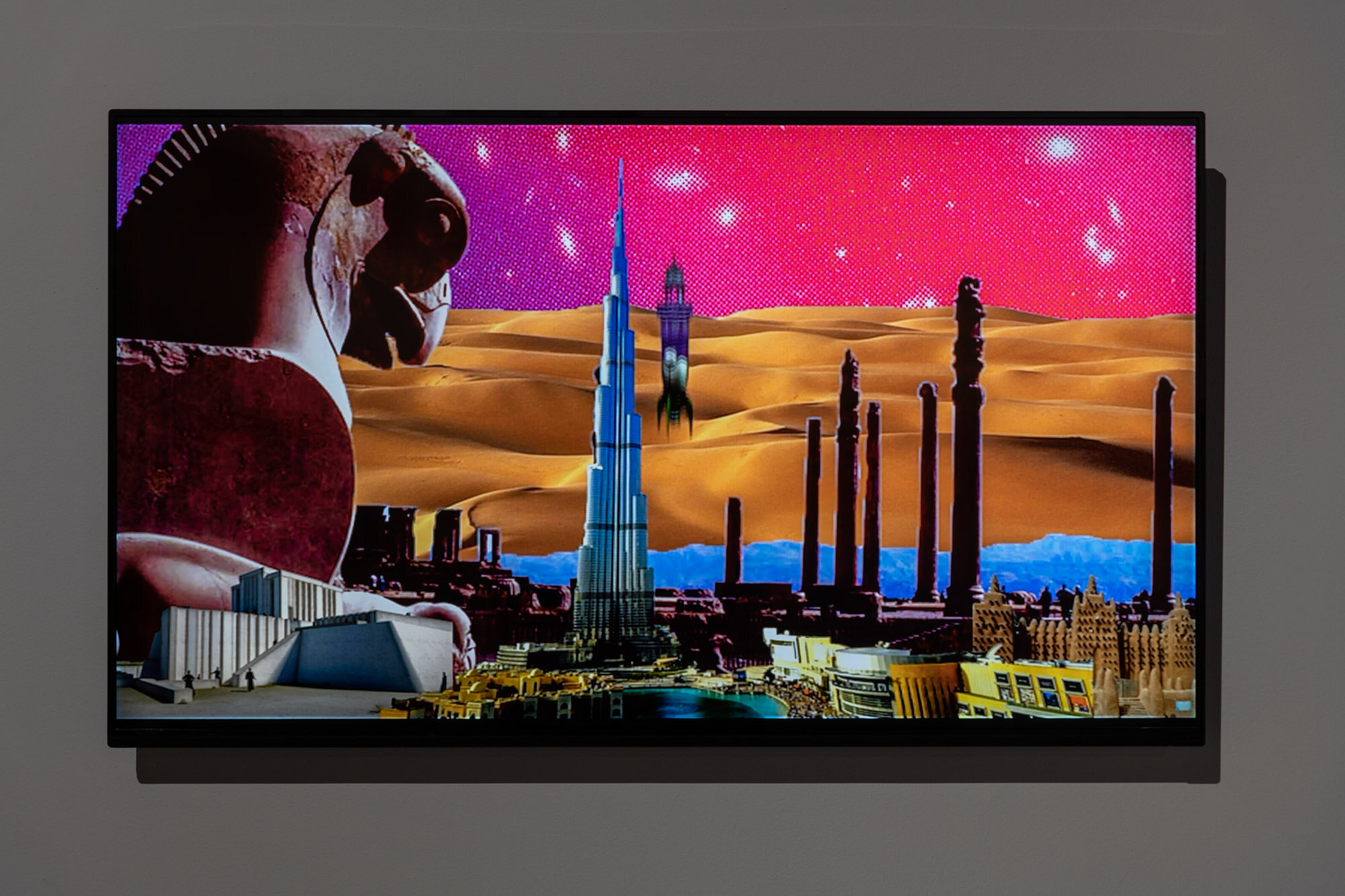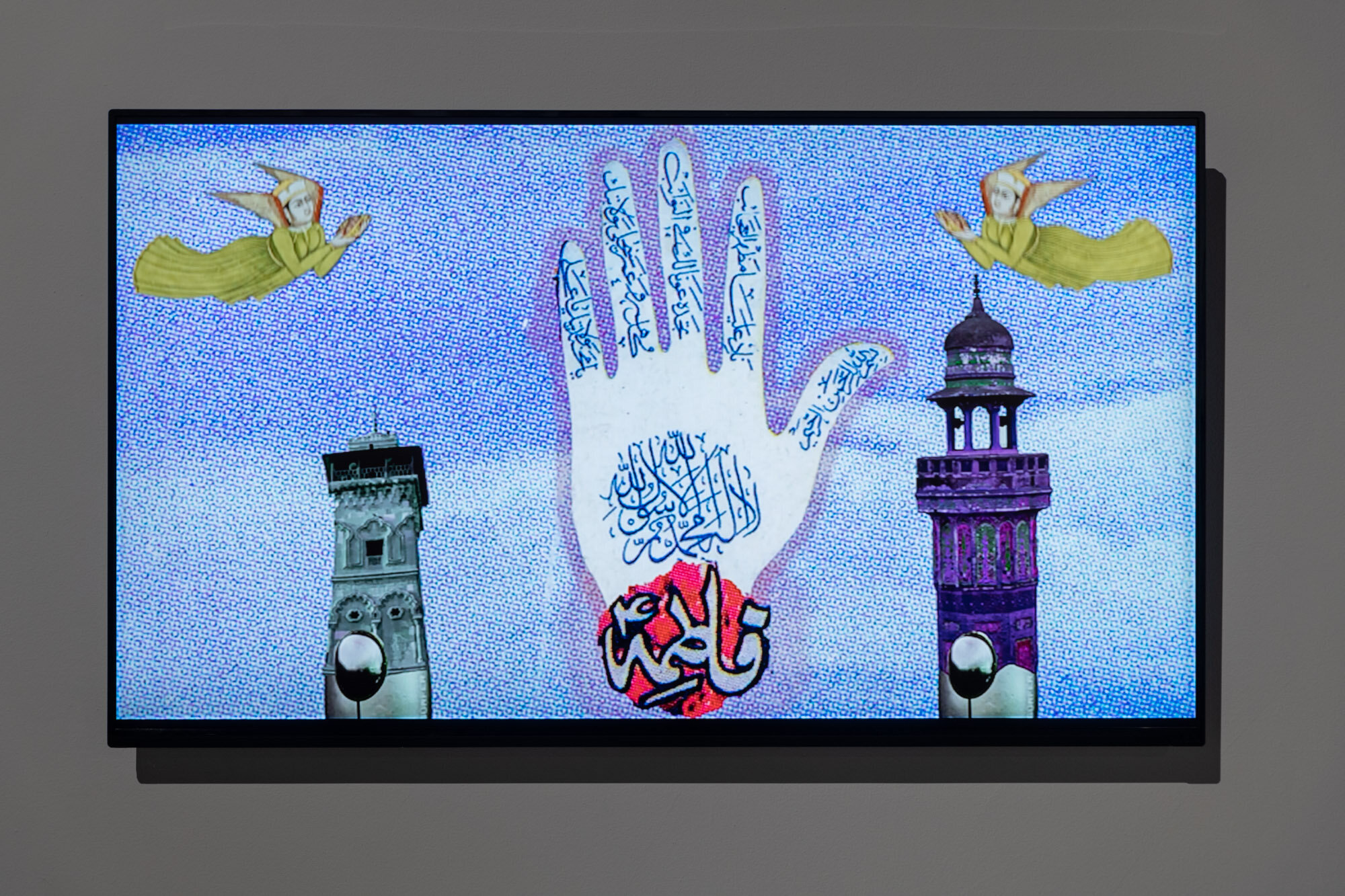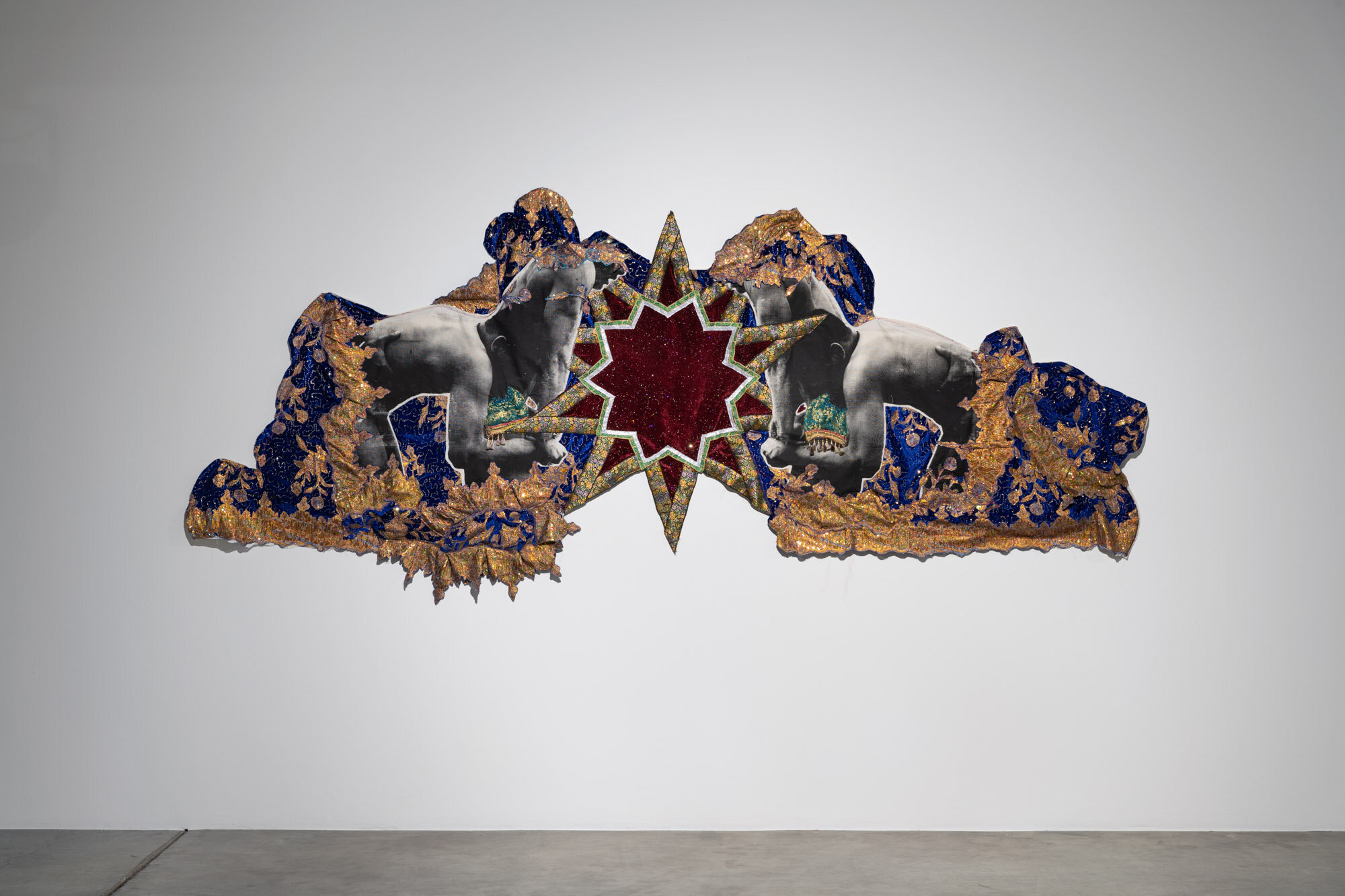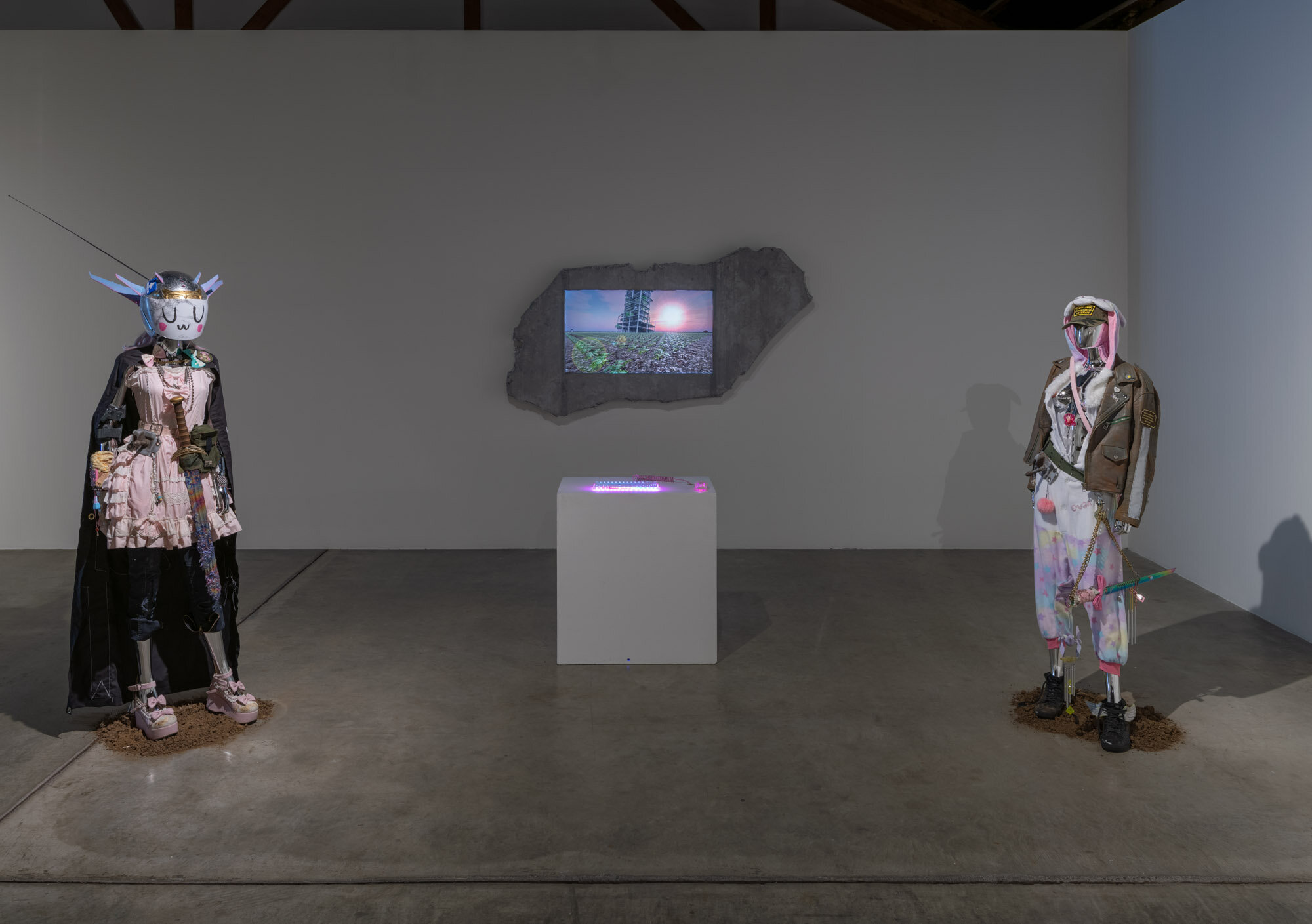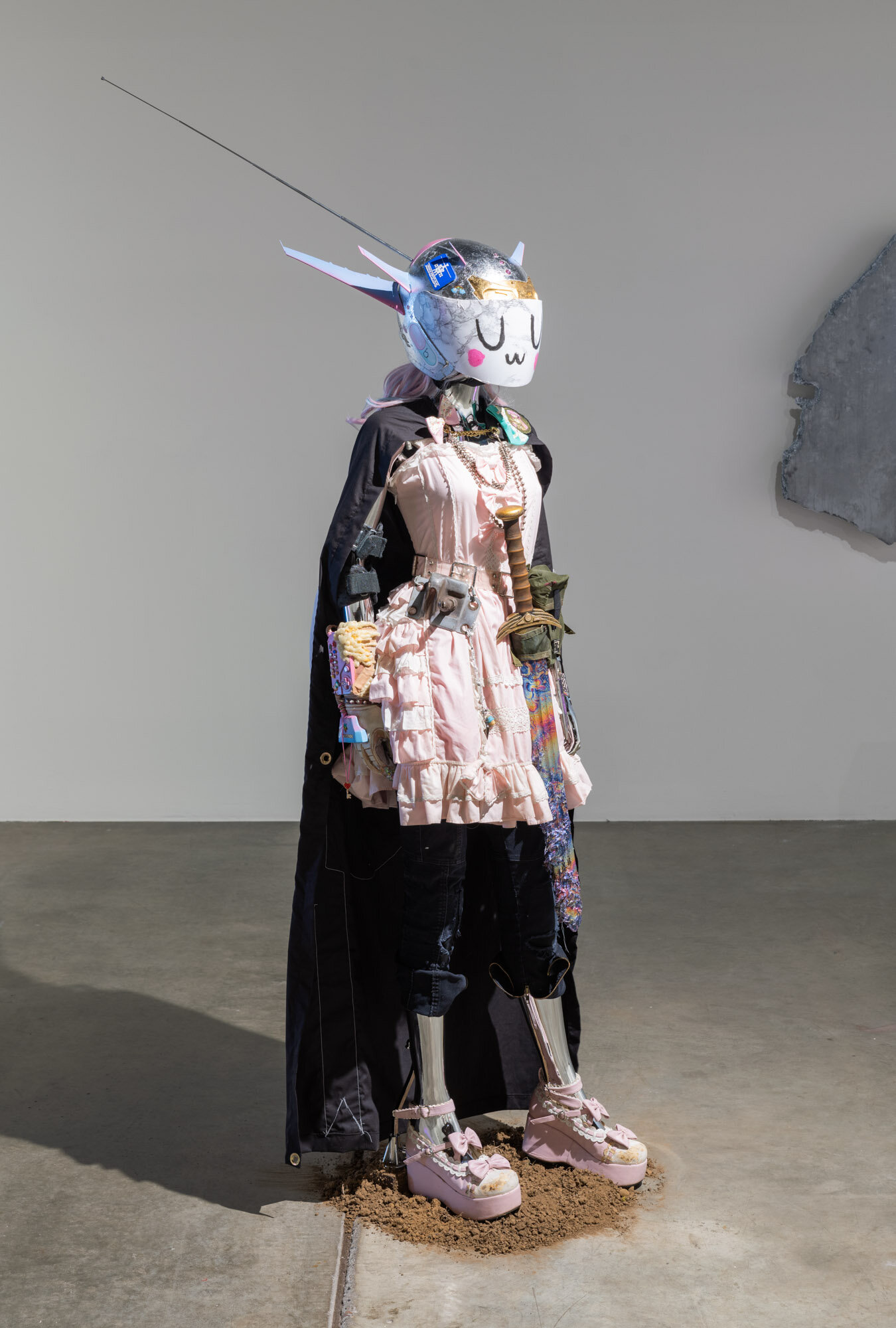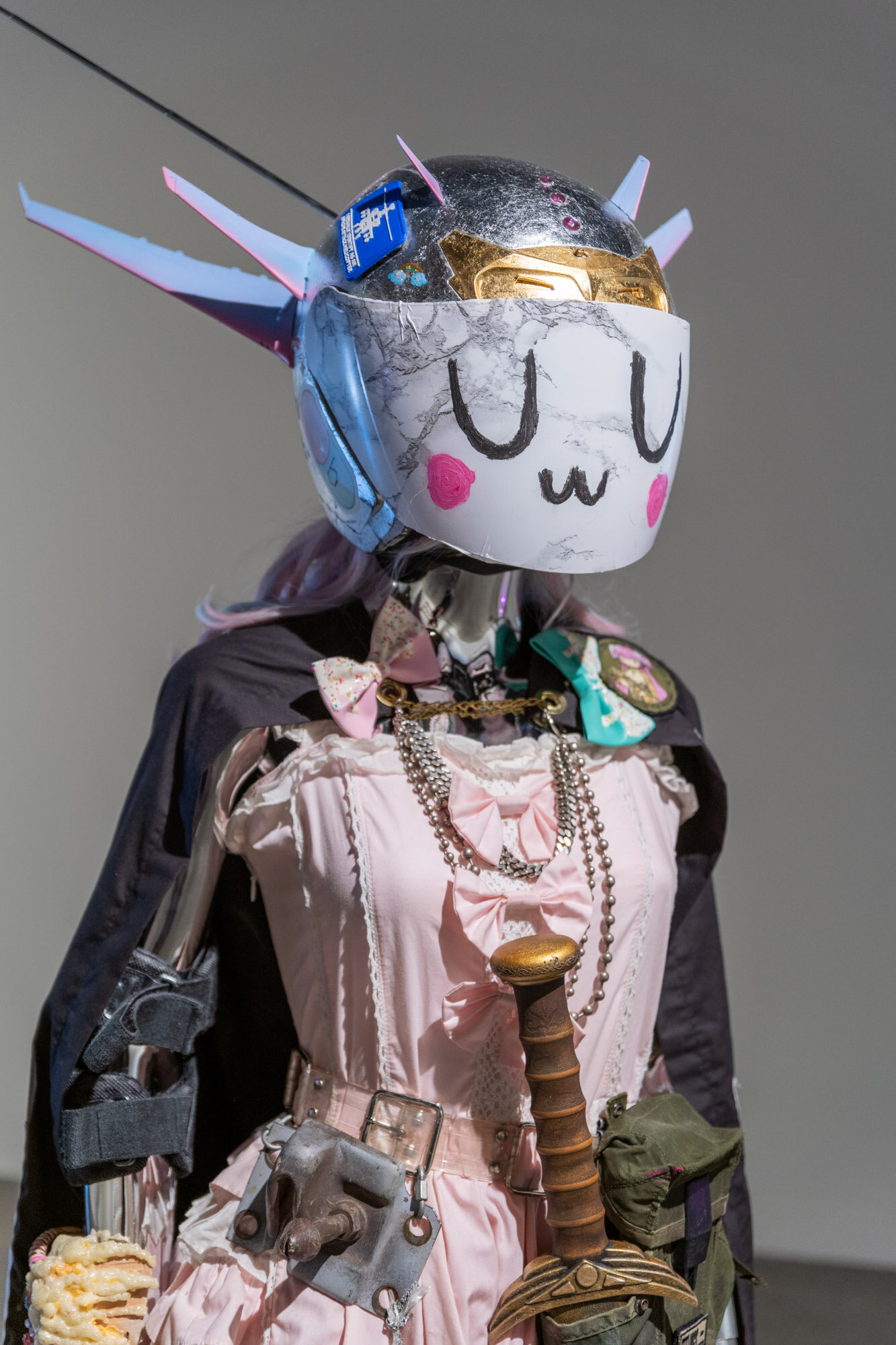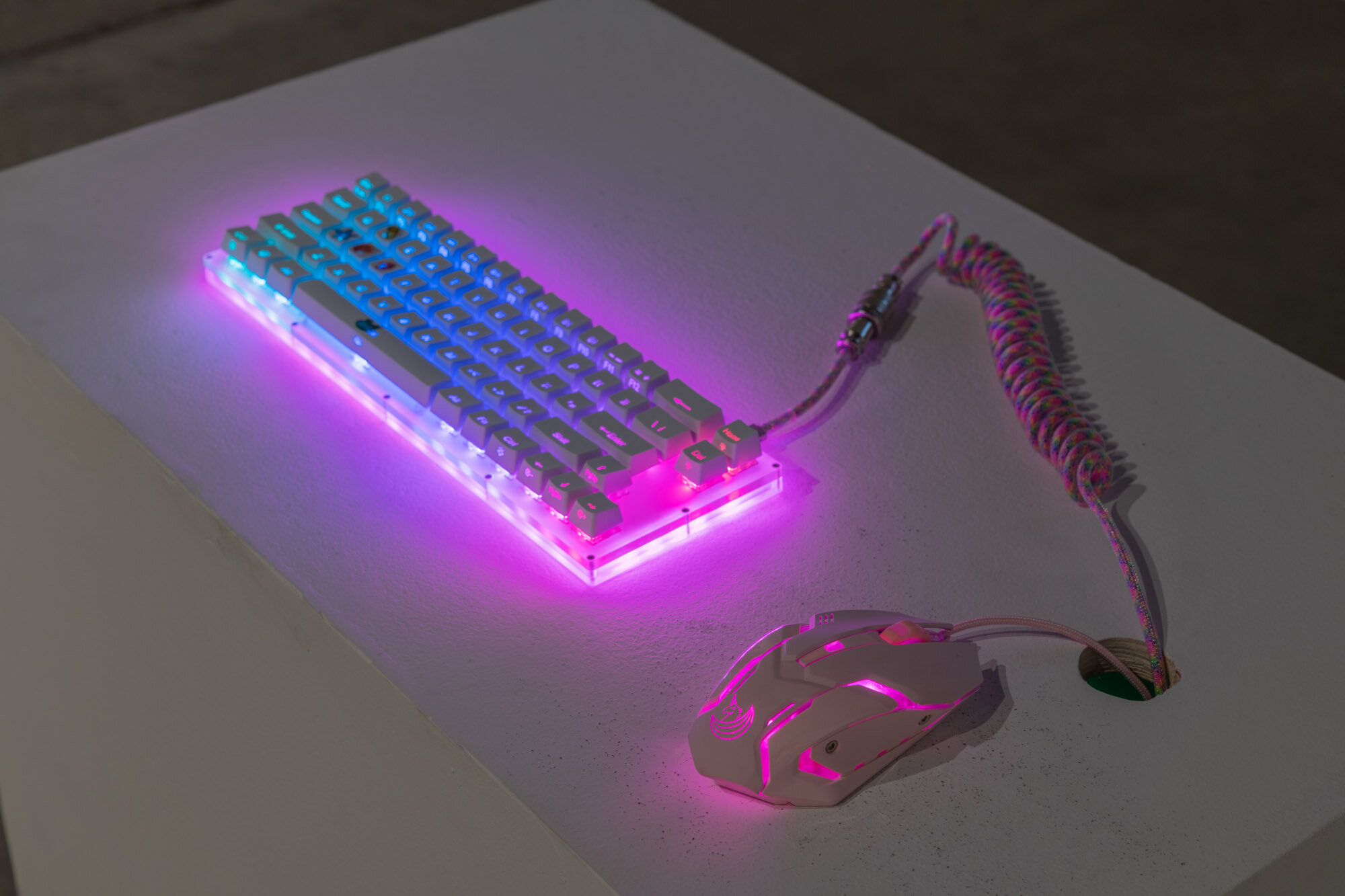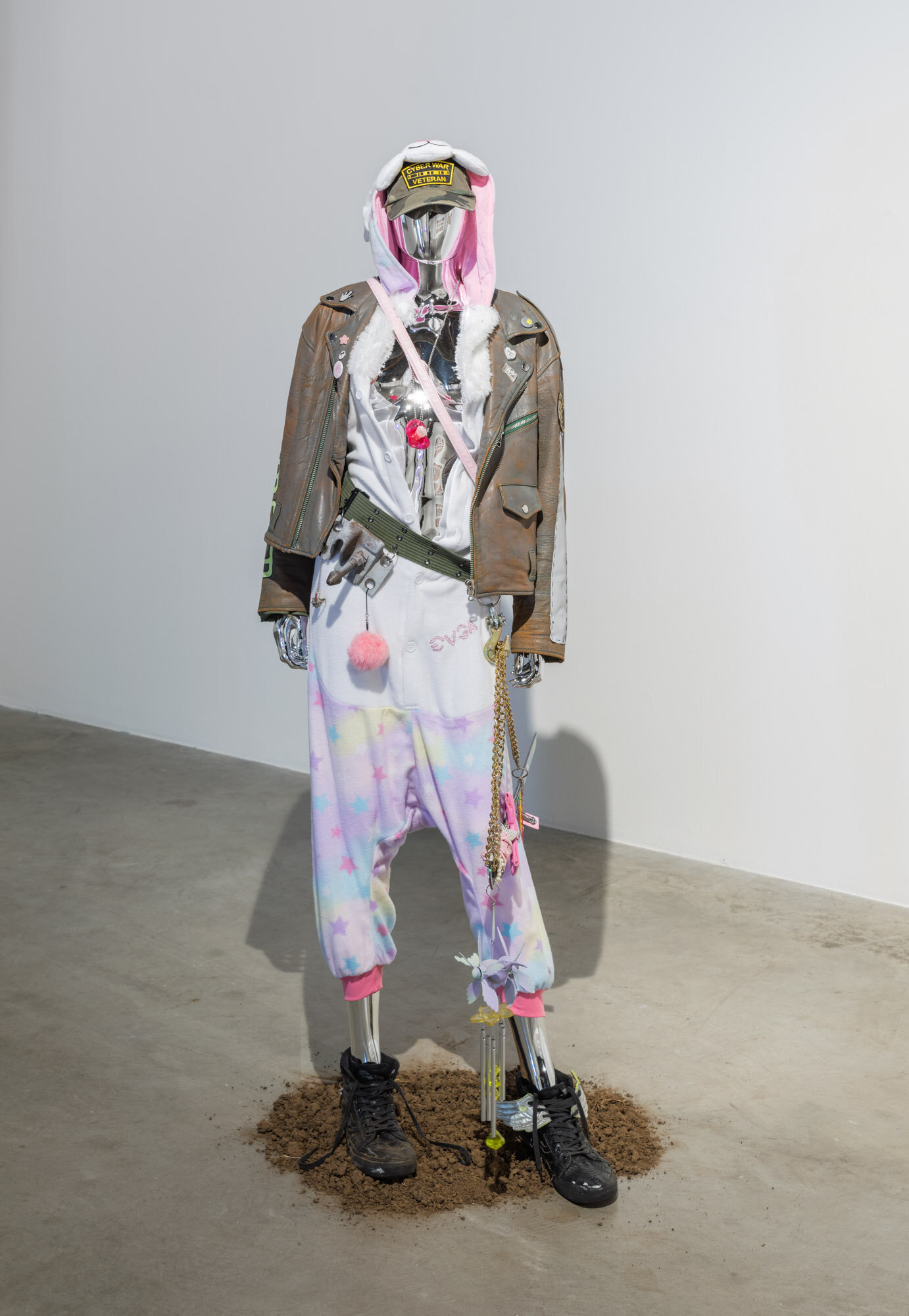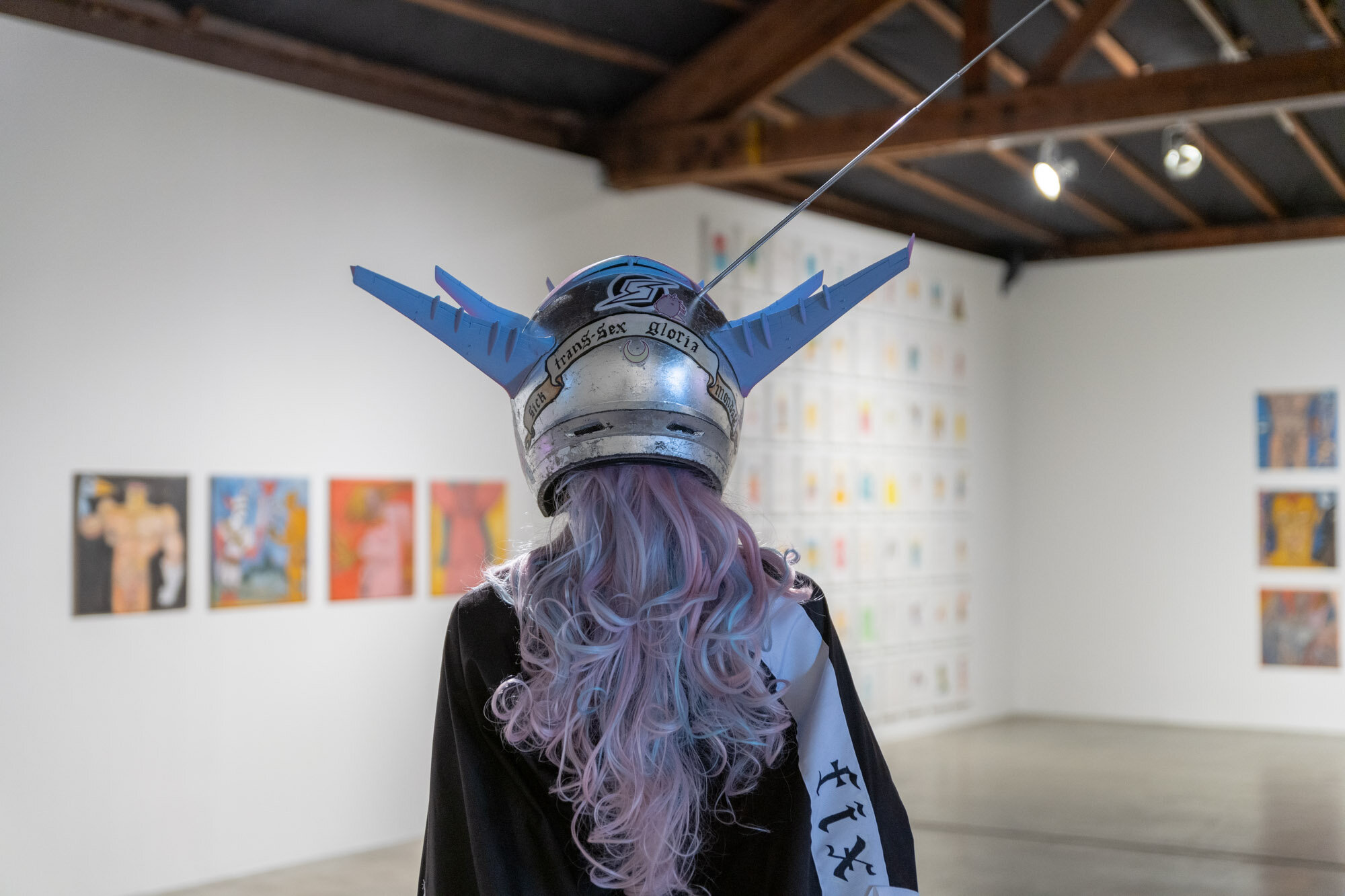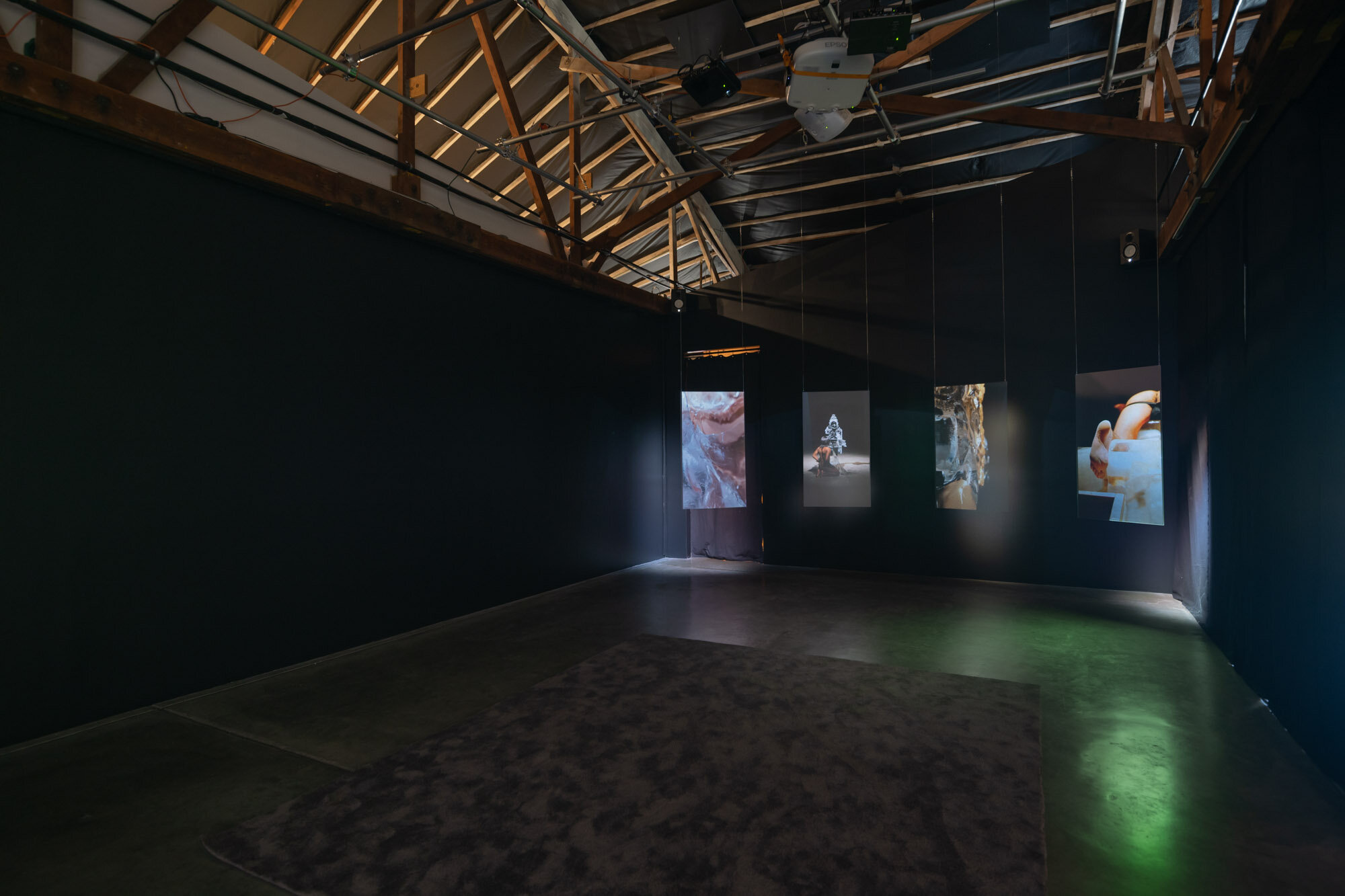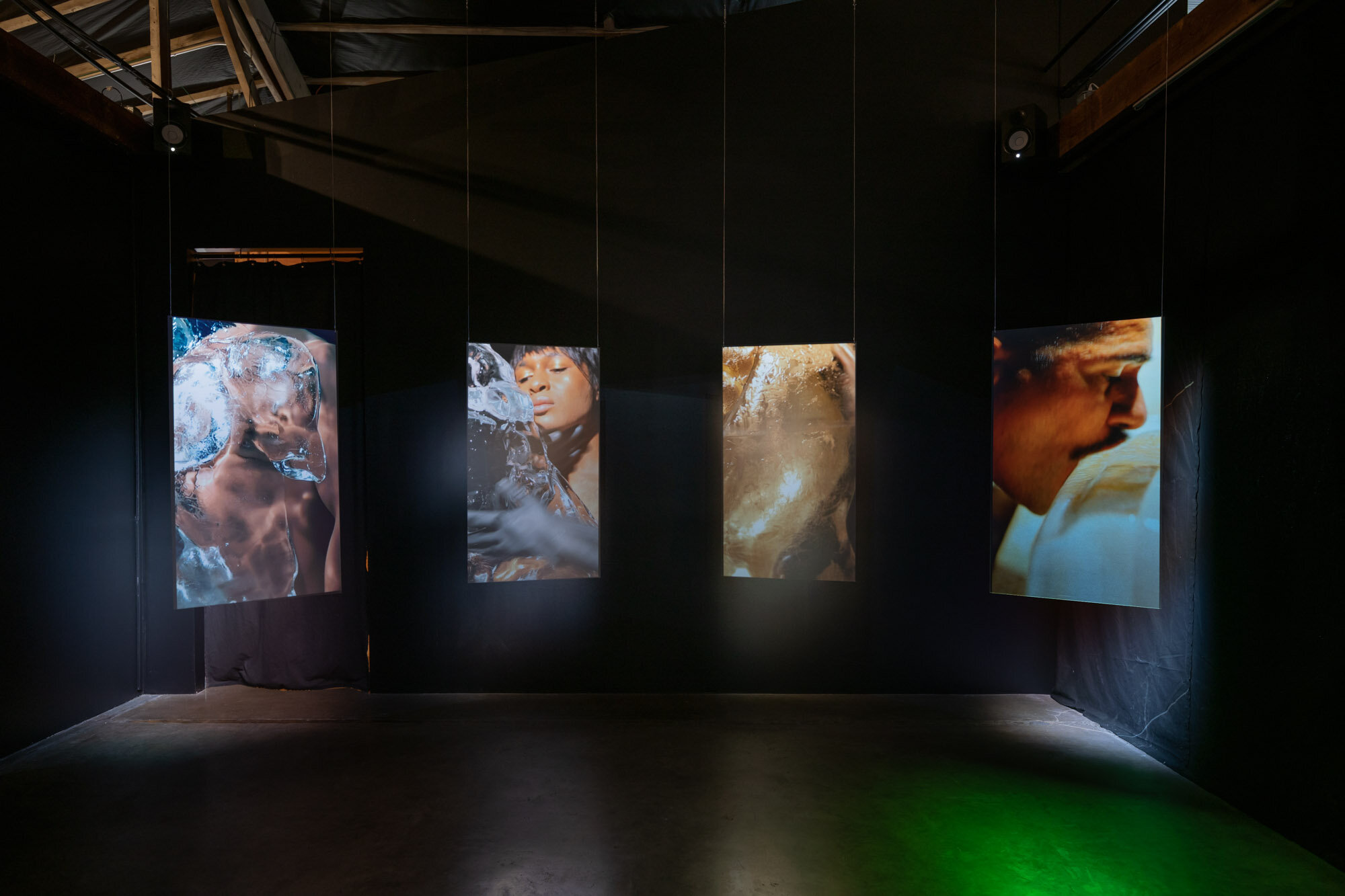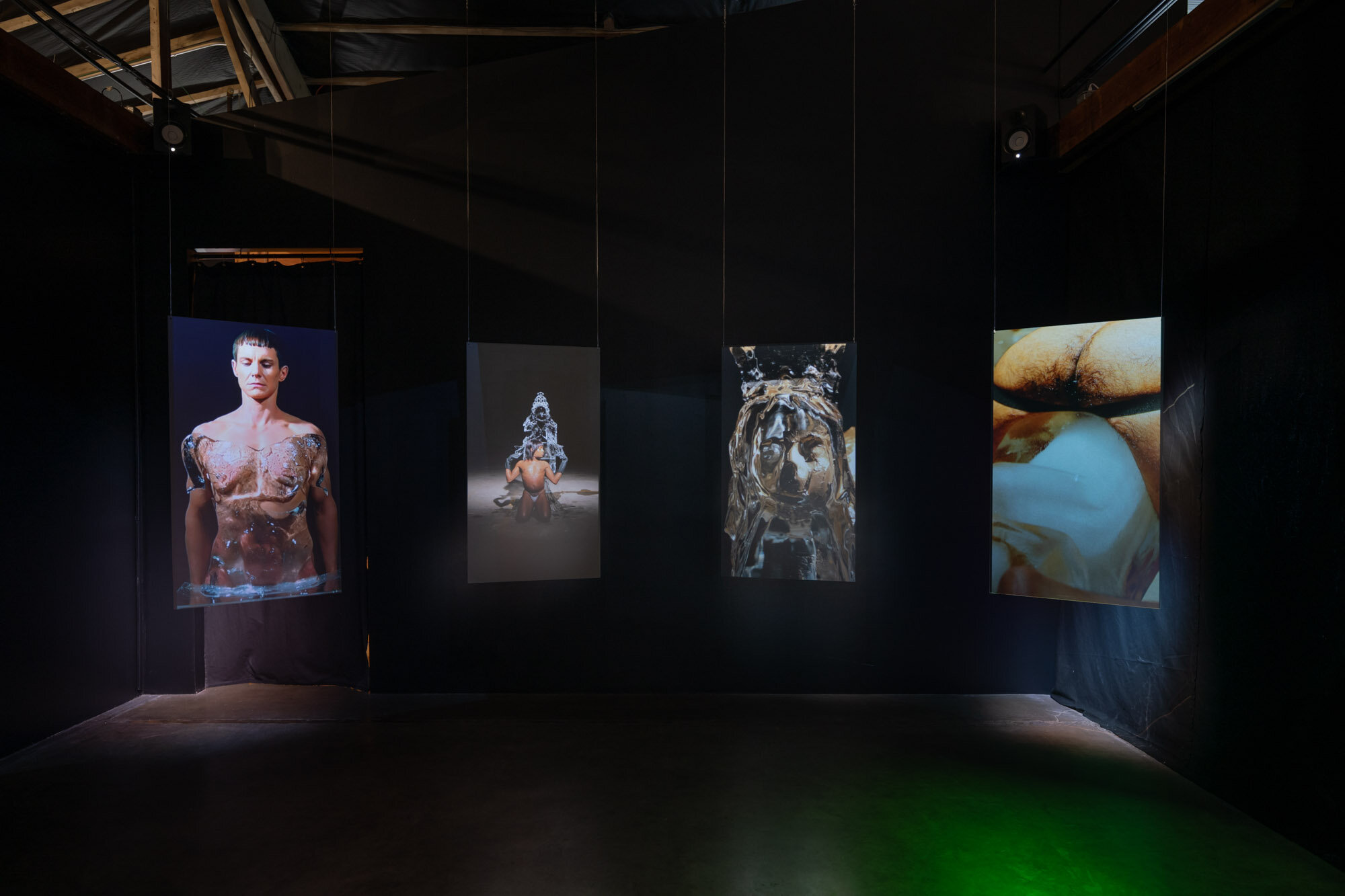ungodly: the spiritual medium
August 7 - September 20, 2020
Photos by Mario Gallucci
Disjecta is proud to announce the opening of ungodly: the spiritual medium, the final exhibition in Justin Hoover's season as Curator in Residence. View this show in-person from August 7 - September 20, 2020. Virtual presentations of the exhibition and programming will be added throughout the exhibition dates.
ungodly: the spiritual medium presents work by artists engaging with alternative versions of classical and modern theology, fairy tales, creation stories, and supernatural iconography. The artists strike out against misogyny, dispel cultural misconceptions about gender and sexuality, and provide inclusive substitutions to narratives of heteronormative power and their implications of social subservience. Featured artists include Zulfikar Ali Bhutto, Tabitha Nikolai, Peter Max Lawrence, Willie Little, and Cassils in collaboration with Rafa Esparza, Fanaa, and Keijaun Thomas.
This exhibition features artworks – performance, painting, multi-media works, sculpture, video, and installation art – that challenge conventional notions of our deities by exploring divergent representations of spiritual power, the supernatural, and resurrection. The word “ungodly” typically refers to something terrible, immoral, or irreligious; in this context it highlights empowering concepts of shifting power to new forms of spiritual communion.
Conventional religious and spiritual frameworks can define who we are, where we have been, and what we value. At best, they lead to growth, trust, healing, and love; at worst, they consecrate exclusionary power in certain sections of society, and absolve divisiveness and violence towards others. This exhibition combats the role of religious and spiritual myth in misogyny, exploitation, and alienation; instead engaging with intersections of race, sexuality, gender, and identity to engender new forms of love, compassion, and spiritual enlightenment.
The 2019-20 Curator in Residence Season 9 is supported by the National Endowment for the Arts. Willie Little’s walking sticks are part of an installation, In Mixed Company, made possible by a 2006 grant from the Pollock Krasner foundation. Tabitha Nikolai’s work received production support by Open Signal. Cassils’s collaborative work with Rafael Esparza, Fanaa, and Keijaun Thomas was made with the support of the Canada Council for the Arts. Special thanks to Open Signal, Upfor, Green Century, and Yale Union for equipment loans.
Based in Los Angeles and from Montreal, Cassils is listed by the Huffington Post as “one of ten transgender artists who are changing the landscape of contemporary art.” Cassils has achieved international recognition for a rigorous engagement with the body as a form of social sculpture. Featuring a series of bodies transformed by strict physical training regimes, Cassils’ artworks offer shared experiences for contemplating histories of violence, representation, struggle, and survival. It is with sweat, blood and sinew that they construct a visual critique around ideologies and histories.
Cassils’ work has been exhibited widely including the School of the Museum of Fine Arts (Boston), MU (Eindhoven), the Deutsches Historisches Museum (Berlin), and the National Theatre (London). A recipient of a United Artist Fellowship (2018), a Guggenheim Fellowship (2017) and a Creative Capital Award (2015), they have received numerous grants from the Canada Council for the Arts (2002-2016), an Alpert Visiting Artist Fellowship from Syracuse University (2016), a California Community Foundation Grant, and a MOTHA (Museum of Transgender Hirstory & Art) award. Cassils has lectured at museums, universities and colleges across the globe such as Goldsmiths University (London) and at Stanford University and the New School Parsons (USA). Their films have premiered at Sundance Film Festival (Utah), OutFest (Los Angeles) and the Institute for Contemporary Art (London).
Rafa Esparza is a multidisciplinary artist who was born, raised, and currently lives in Los Angeles. Woven into Esparza’s bodies of work are his interests in history, personal narratives, and kinship. He is inspired by his own relationship to colonization and the disrupted genealogies that it produces. Using live performance as his main form of inquiry, Esparza employs site-specificity, materiality, memory, and what he calls (non)documentation as primary tools to investigate and expose ideologies, power structures, and binary forms of identity that establish narratives, history, and social environments. Esparza’s recent projects have evolved through experimental collaborative projects grounded in laboring with land vis-à-vis adobe brickmaking, a skill learned from his father, Ramón Esparza. In so doing, the artist intends to divert institutional resources to invited Brown and Queer cultural producers to realize large-scale collective projects. In the process, he gathers people together to build networks of support outside of traditional art spaces. He is especially committed to working in the local geographies that are the Southwest, including Mexico and Latin America.
Esparza is a recipient of an Emerging Artist 2014 California Community Foundation Fellowship for Visual Arts, a 2014 Art Matters grantee, and a 2015 recipient of a Rema Hort Mann Foundation Emerging Artist Grant. He has performed in a variety of spaces, both public and private, throughout Los Angeles, including Elysian Park, the Los Angeles River, AIDS Project Los Angeles, Highways Performance Space, REDCAT, Human Resources, Vincent Price Art Museum, LACE (Los Angeles Contemporary Exhibitions), and the J. Paul Getty Museum. Esparza has also shown throughout the United States in art institutions such as the Whitney Museum of American Art, the Bemis Center for Contemporary Art, and Ballroom Marfa, and internationally at Oficina de Procesos, Mexicali, and El Museo del Chopo in CDMX. Esparza was part of the 2018 spring cohort at the renowned Artpace artist-in-residence program in San Antonio, Texas, and recently led a guerrilla processional performance with over 25 artists through the historic fashion thoroughfare market The Santee Alley as part of his project, de la Calle (of the Street), in collaboration with the Institute of Contemporary Art, Los Angeles.
Fanaa (born in Hyderabad, India, based in Los Angeles, CA) works across film, visual art, performance and sound. She is interested in counter-archives, speculative documentaries, and the intersections of fact and fiction, and is currently exploring themes of embodiment and mysticism, particularly within the Islamic Sufi context. Her work emerges from the complexities of inhabiting multiple personas – woman, Muslim, immigrant, citizen – and is conceptualized in feminist modes outside of the Western model. Narrative threads include migration, celebration, warfare, nostalgia, homeland, and borders, often within realms of Islamic influence, through both traditional forms and kaleidoscopic reinventions via pop culture. She is the founder of Discostan, a collaborative decolonial project working with cultural production from the SWANA (South and West Asia and North Africa) region.
Fanaa's work has been featured at Museum of Contemporary Art Tucson, the Station Museum of Contemporary Art, Broad Museum, LACE, Toronto International Film Festival, MOMA New York, Hammer Museum, LAXArt, Centre Georges Pompidou, and the Pacific Film Archive. Currently, she hosts and produces monthly radio shows on Dublab and NTS, and recently released an album of field recordings from Pakistan on the Sublime Frequencies label. She received her MFA in Film and Video from California Institute of the Arts in 2005, and is a recipient of the California Community Foundation Visual Artist Fellowship, the Rema Hort Mann Emerging Artist Grant, and the Onassis AIR Fellowship.
Keijaun Thomas is a New York based artist and Franklin Furnace Fund Recipient for 2018. Her work in performance, multimedia installation, and poetry explores the labor of black femmes in situations ranging from housework and hairdressing to athletic training and exotic dancing. Her performances combine rhapsodic layers of live and recorded voice, and her poems slip between various modes of address, exploring the pleasures and pressures of dependency, care, and support. Thomas underscores the endurance and intimacy care work demands of those expected to perform it—predominantly black women, black femmes and people of color. She aims to build bridges of understanding, community and care through her pieces. Her work centers and focuses on self/communal care in real time and creating safer spaces for black and people of color to rethink, rework and reflect. Thomas earned her Masters degree from the School of the Art Institute of Chicago and BFA from the School of Visual Arts. Thomas has presented work nationally and internationally at the Broad Museum, the Station Museum of Contemporary Art, the New Museum of Contemporary Art, Performance Space NY, Performance Space UK, MAI (Montréal, arts interculturels, Wrightwood 659, Arnolfini UK, Human Resources Los Angeles, the Hyde Park Art Center, the Knockdown Center,Centro Cultural del México Contemporaneo,Issue Project Room, Stanford University, Harvard University and Théâtre de la Ville, as well as, at Rapid Pulse International Performance Festival, SPILL Festival of Performance, Itinerant Performance Art Festival, Queer Arts Festival, Time Based Arts Festival ,The Rhubarb Festival, Fierce Festival, Performatorium 5: EXPOSE ,Encuentro- Hemispheric Institute of Performance & Politics and ANTI - Contemporary Art Festival where she was nominated for the International Prize for Live Art. Thomas has been an artist in residence at SPACE studios, Ox Bow school of Art, ACRE Residency and the Creative Exchange Lab Artist Residency.
About the artwork: Solution (4-channel video installation)
Cassils invited artists Fanaa, Keijaun Thomas and Rafa Esparza to collaborate on Solution. Originally, this work was created as a live performance and sculptural video installation that reinterprets and expands upon Tiresias, Cassil’s performance video about the Greek myth transgender transformation by the gods. These artists’ subjective positions differ but they all share the experience of living through a time on erosion of civil rights under the current US administration. Each artist conceived of a performance action in which they melt an ice sculpture of a symbol of their choice with their bodies. Videos of these performances are installed to formally reference the classical sculptures of divine figures found in temples of worship.
This collaborative work poses the following question: What if the constitutional right to religious freedom were invoked to protect a religion where our deities were brown people, Muslims, women and queers? What if to harm such a body was framed, not as the quotidian victim of police brutality, xenophobia or transphobia but as an act of religious persecution: would the sanctity of our lives finally be given value?
Zulfikar Ali Bhutto (b. Damascus, 1990) is a visual artist, performer and curator. Bhutto’s work explores complex histories of colonialism that are exacerbated by contemporary international politics and in the process unpacks the intersections of queerness and Islam through a multi-media practice. Bhutto was curatorial resident at SOMArts Cultural Center where he co-curated, The Third Muslim: Queer and Trans Muslim Narratives of Resistance and Resilience and has shown in galleries, museums and theaters globally. He has spoken extensively on the intersections of faith, radical thought and futurity at Columbia University, UC Berkeley, and The California College of the Arts and Mills College. Bhutto is currently based in San Francisco, California where he received an MFA at the San Francisco Art Institute in 2016.
About the work: Grace, Mercy and the Modern Attack
In this fabric installation the minaret of The Great Mosque of Aleppo is resurrected as a spaceship named Grace 258 designed to carry away intergalactic refugees from an earth that has become less and less tolerable to live on, while the minaret of the Wazir Khan Mosque is taken apart and repurposed for the same reason, instead she is named Mercy 298. Both are rendered as heroic tapestries, a reminder of a time when we were saved by the most unusual heroes, below them wrestler warriors are valorized in an opulent quilt named Modern Attack. A shrine is built in remembrance, the future has already been.
In a capitalist world where the wealthy get to board private planes to leave behind disease and warfare, queer Muslim future rebel leaders use the technologies of divination, numerology and guerrilla style engineering to secure the lives of those in need. An accompanying video tracks the flight of these spaceships from earth to the cosmos where they land and accelerate human evolution, humanoids adjust to live on another planet while the revolution rages on earth. We need to secure its existence; we have been promised its inheritance.
Peter Max Lawrence is a content-maker. Born in Topeka; adopted soon thereafter and raised in Kansas City, Kansas. Over the course of his life, he has created a large and diverse body of work, exploring a wide variety of approaches, media, tools and themes. Lawrence’s works have been presented internationally in venues ranging from basement bathrooms to major museums. Currently he is the creator and curator for The One and Lid Off Film Festival as well as developing a slew of collaborations with other artists, musicians, and writers.
Peter Max Lawrence is a filmmaker, artist, and poet. His work has been shown at the de Young Museum, Legion of Honor, Yerba Buena Center for the Arts, and SOMArts. He has work in the permanent collections of SFMOMA, UC Davis Library and KQED. Raised in Kansas City, Kansas(Wyandotte County), Lawrence currently lives in a van with his cat Trouble-Maker rotating time in San Francisco, Southern Colorado, Lucas, Kansas and Kansas City.
About the work: Old Fashioned Dilemmas For Contemporary Deities
For me, all work begins with a mark on a surface; drawing and sketching equal existing. Drawing is at the heart of my engagements as a maker; this is the case for painting, sculpture, performance or video. I am fascinated with the magick ritual of completing gestures which provide parallels with my life experience; marks which are able to express my feelings for form, space, light, movement and play. I also consider drawing to be a personal and private forum to explore a unique interior, a tool for documentation of dreams, feelings and memories.
I am consistently exploring a gender-queer vision of supposedly hetero-normative body ideals encompassed through the lens of global myths, science-fiction and superhero tropes. I fill my works with interchanging characters that inhabit a fictional universe that is their unique domain. These "actors," as I call them, are manifested and take inspiration from a wide array of media and themes, including but not limited to anthropology, pop culture, religion and history.
Multimedia, installation artist and storyteller, Willie Little was born in rural North Carolina and currently resides in Portland Oregon. Many of his works are rooted in the Southern traditions of North Carolina. Through his visual narratives, he documents a fading part of a rural lifestyle.
Willie received his B.A. from the University of North Carolina at Chapel Hill. He has had solo exhibitions at the Smithsonian Institution in Washington DC, The Center for Documentary Studies at Duke University, and the Pounder Kone' Artspace in Los Angeles. Notable group exhibitions have been at the Corcoran in Washington DC, the California Folk Art Museum in Los Angeles and the SF MOMA Artist's Gallery.
Little's work is a cultural testament to Southern rural traditions, family dynamics and it identifies with universal experiences that cross racial and socio-economic lines.
About the work: And Miles to Go Before We Sleep
This installation consists of seven artist made sculptures inspired by majestic African walking sticks. They could possibly represent fences, barriers, African scepters, staffs, batons, to protect, to exalt. They could be emblematic of nobility, an instrument of battle or ritual. They could possibly suggest we as humans move beyond hatred for one another and embrace our commonalties. We were all born with the capacity to love, have compassion for one another. Hate is learned. This installation is a metaphorical and spiritual journey to enlightenment. We must take action to heal the divides of race and class in America.
Adorned with cockleburs—prickly seed pods that could represent African hair in its natural state—once a racial epithet, our hair is considered a symbol of strength and resilience. As many of us embrace the texture of our hair, we can say today, as we many echoed in the 60s and 70s, our hair is beautiful. Blackness is beautiful. The objects are capped with symbolic crowns interpreted by the artist to represent shared human characteristics including: the halo (female); horn (male); the flame (seeking direction as a light on our life journey); and the diamond (representing riches, for there are many that have little to do with money).
Tabitha Nikolai is a trashgender gutter elf and low-level cybermage raised in Salt Lake City, Utah, and based in Portland, Oregon. She creates the things that would have better sustained her younger self–simulations of a more livable future, and the obstacles that intervene. These look like: fictive text, videogames, cosplay, and earnest rites of suburban occult. Currently she teaches and manages galleries for the Portland State University School of Art + Design. Her work has been shown at the Portland Institute for Contemporary Art, the Utah Museum of Contemporary Art, Vox Populi in Philadelphia, Ganka Gallery in Tokyo, and has been covered by i-D Magazine, the New York Times, and Art in America. She hopes you're doing okay.
About the work: Sick Trans-Sex Gloria
Sick Trans-Sex Gloria is a series of sci-fi inspired costumes and a virtual environment imagining armors of transgender resilience and a distinctly femme trans-futurism. The piece draws inspiration from diffuse online queer covens, girls in the Black Bloc, and the cybernetic ecstasy of the blur between prosthesis (whether hormone or silicone) and body. This experiment in queer world building endeavors to manifest as physical a culture often incubated in the ephemeral.

